Analysis of Sustainable Food Production in the Dairy Sector
VerifiedAdded on 2020/04/29
|19
|4876
|72
Report
AI Summary
This report provides an in-depth analysis of the transition from unsustainable to sustainable food production, with a specific focus on the dairy industry. It examines past and current practices in both developing and developed nations, highlighting the evolution of dairy farming and its impact on the ...
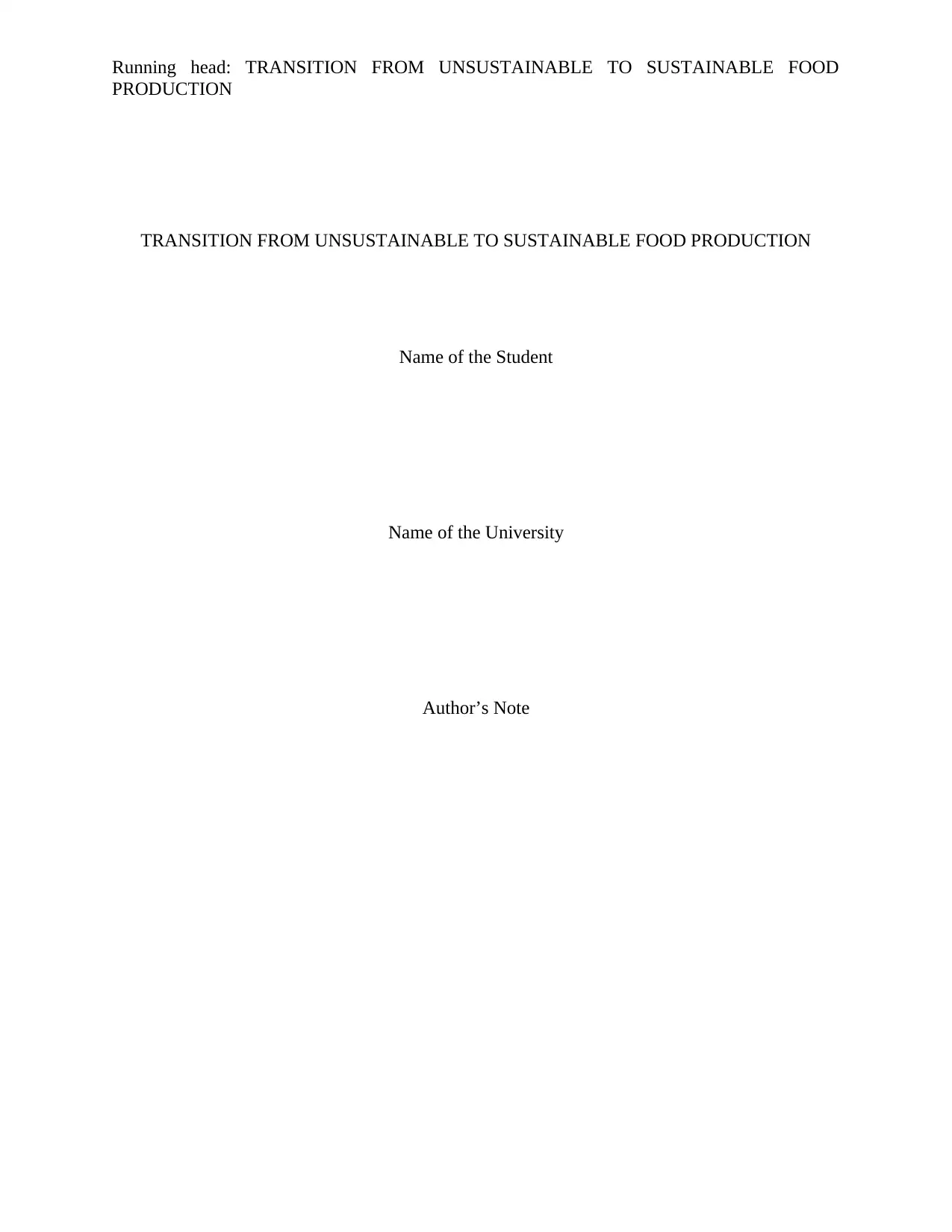
Running head: TRANSITION FROM UNSUSTAINABLE TO SUSTAINABLE FOOD
PRODUCTION
TRANSITION FROM UNSUSTAINABLE TO SUSTAINABLE FOOD PRODUCTION
Name of the Student
Name of the University
Author’s Note
PRODUCTION
TRANSITION FROM UNSUSTAINABLE TO SUSTAINABLE FOOD PRODUCTION
Name of the Student
Name of the University
Author’s Note
Secure Best Marks with AI Grader
Need help grading? Try our AI Grader for instant feedback on your assignments.
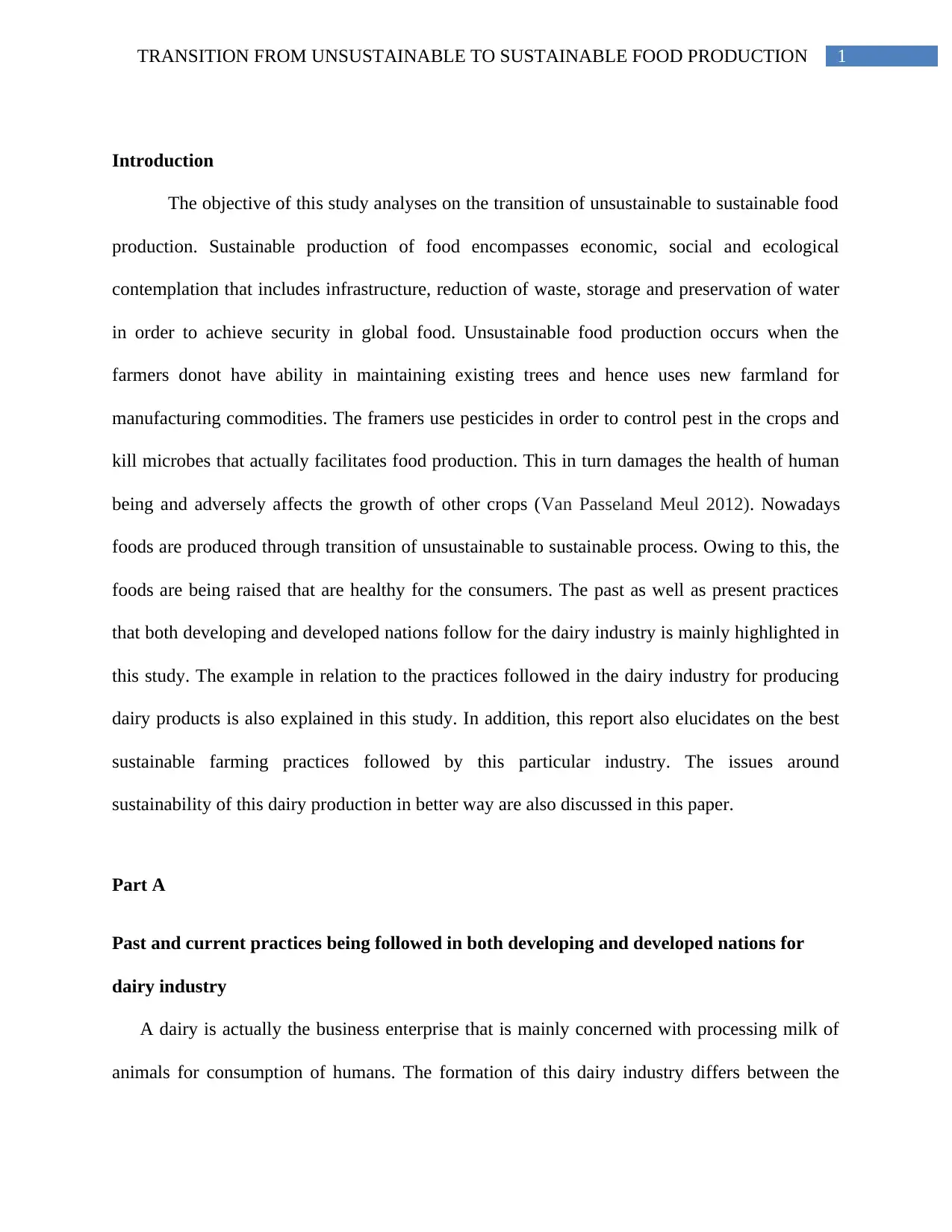
1TRANSITION FROM UNSUSTAINABLE TO SUSTAINABLE FOOD PRODUCTION
Introduction
The objective of this study analyses on the transition of unsustainable to sustainable food
production. Sustainable production of food encompasses economic, social and ecological
contemplation that includes infrastructure, reduction of waste, storage and preservation of water
in order to achieve security in global food. Unsustainable food production occurs when the
farmers donot have ability in maintaining existing trees and hence uses new farmland for
manufacturing commodities. The framers use pesticides in order to control pest in the crops and
kill microbes that actually facilitates food production. This in turn damages the health of human
being and adversely affects the growth of other crops (Van Passeland Meul 2012). Nowadays
foods are produced through transition of unsustainable to sustainable process. Owing to this, the
foods are being raised that are healthy for the consumers. The past as well as present practices
that both developing and developed nations follow for the dairy industry is mainly highlighted in
this study. The example in relation to the practices followed in the dairy industry for producing
dairy products is also explained in this study. In addition, this report also elucidates on the best
sustainable farming practices followed by this particular industry. The issues around
sustainability of this dairy production in better way are also discussed in this paper.
Part A
Past and current practices being followed in both developing and developed nations for
dairy industry
A dairy is actually the business enterprise that is mainly concerned with processing milk of
animals for consumption of humans. The formation of this dairy industry differs between the
Introduction
The objective of this study analyses on the transition of unsustainable to sustainable food
production. Sustainable production of food encompasses economic, social and ecological
contemplation that includes infrastructure, reduction of waste, storage and preservation of water
in order to achieve security in global food. Unsustainable food production occurs when the
farmers donot have ability in maintaining existing trees and hence uses new farmland for
manufacturing commodities. The framers use pesticides in order to control pest in the crops and
kill microbes that actually facilitates food production. This in turn damages the health of human
being and adversely affects the growth of other crops (Van Passeland Meul 2012). Nowadays
foods are produced through transition of unsustainable to sustainable process. Owing to this, the
foods are being raised that are healthy for the consumers. The past as well as present practices
that both developing and developed nations follow for the dairy industry is mainly highlighted in
this study. The example in relation to the practices followed in the dairy industry for producing
dairy products is also explained in this study. In addition, this report also elucidates on the best
sustainable farming practices followed by this particular industry. The issues around
sustainability of this dairy production in better way are also discussed in this paper.
Part A
Past and current practices being followed in both developing and developed nations for
dairy industry
A dairy is actually the business enterprise that is mainly concerned with processing milk of
animals for consumption of humans. The formation of this dairy industry differs between the
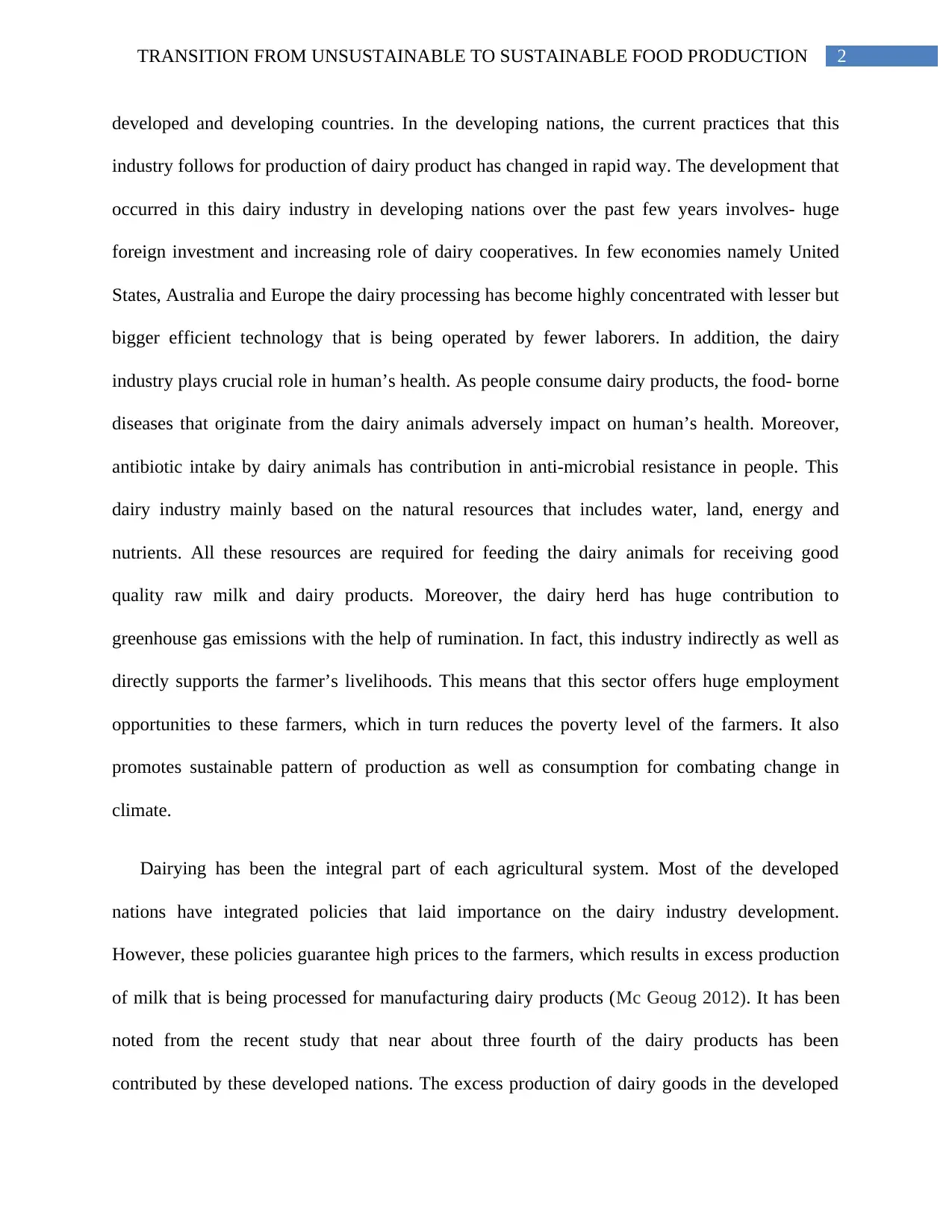
2TRANSITION FROM UNSUSTAINABLE TO SUSTAINABLE FOOD PRODUCTION
developed and developing countries. In the developing nations, the current practices that this
industry follows for production of dairy product has changed in rapid way. The development that
occurred in this dairy industry in developing nations over the past few years involves- huge
foreign investment and increasing role of dairy cooperatives. In few economies namely United
States, Australia and Europe the dairy processing has become highly concentrated with lesser but
bigger efficient technology that is being operated by fewer laborers. In addition, the dairy
industry plays crucial role in human’s health. As people consume dairy products, the food- borne
diseases that originate from the dairy animals adversely impact on human’s health. Moreover,
antibiotic intake by dairy animals has contribution in anti-microbial resistance in people. This
dairy industry mainly based on the natural resources that includes water, land, energy and
nutrients. All these resources are required for feeding the dairy animals for receiving good
quality raw milk and dairy products. Moreover, the dairy herd has huge contribution to
greenhouse gas emissions with the help of rumination. In fact, this industry indirectly as well as
directly supports the farmer’s livelihoods. This means that this sector offers huge employment
opportunities to these farmers, which in turn reduces the poverty level of the farmers. It also
promotes sustainable pattern of production as well as consumption for combating change in
climate.
Dairying has been the integral part of each agricultural system. Most of the developed
nations have integrated policies that laid importance on the dairy industry development.
However, these policies guarantee high prices to the farmers, which results in excess production
of milk that is being processed for manufacturing dairy products (Mc Geoug 2012). It has been
noted from the recent study that near about three fourth of the dairy products has been
contributed by these developed nations. The excess production of dairy goods in the developed
developed and developing countries. In the developing nations, the current practices that this
industry follows for production of dairy product has changed in rapid way. The development that
occurred in this dairy industry in developing nations over the past few years involves- huge
foreign investment and increasing role of dairy cooperatives. In few economies namely United
States, Australia and Europe the dairy processing has become highly concentrated with lesser but
bigger efficient technology that is being operated by fewer laborers. In addition, the dairy
industry plays crucial role in human’s health. As people consume dairy products, the food- borne
diseases that originate from the dairy animals adversely impact on human’s health. Moreover,
antibiotic intake by dairy animals has contribution in anti-microbial resistance in people. This
dairy industry mainly based on the natural resources that includes water, land, energy and
nutrients. All these resources are required for feeding the dairy animals for receiving good
quality raw milk and dairy products. Moreover, the dairy herd has huge contribution to
greenhouse gas emissions with the help of rumination. In fact, this industry indirectly as well as
directly supports the farmer’s livelihoods. This means that this sector offers huge employment
opportunities to these farmers, which in turn reduces the poverty level of the farmers. It also
promotes sustainable pattern of production as well as consumption for combating change in
climate.
Dairying has been the integral part of each agricultural system. Most of the developed
nations have integrated policies that laid importance on the dairy industry development.
However, these policies guarantee high prices to the farmers, which results in excess production
of milk that is being processed for manufacturing dairy products (Mc Geoug 2012). It has been
noted from the recent study that near about three fourth of the dairy products has been
contributed by these developed nations. The excess production of dairy goods in the developed
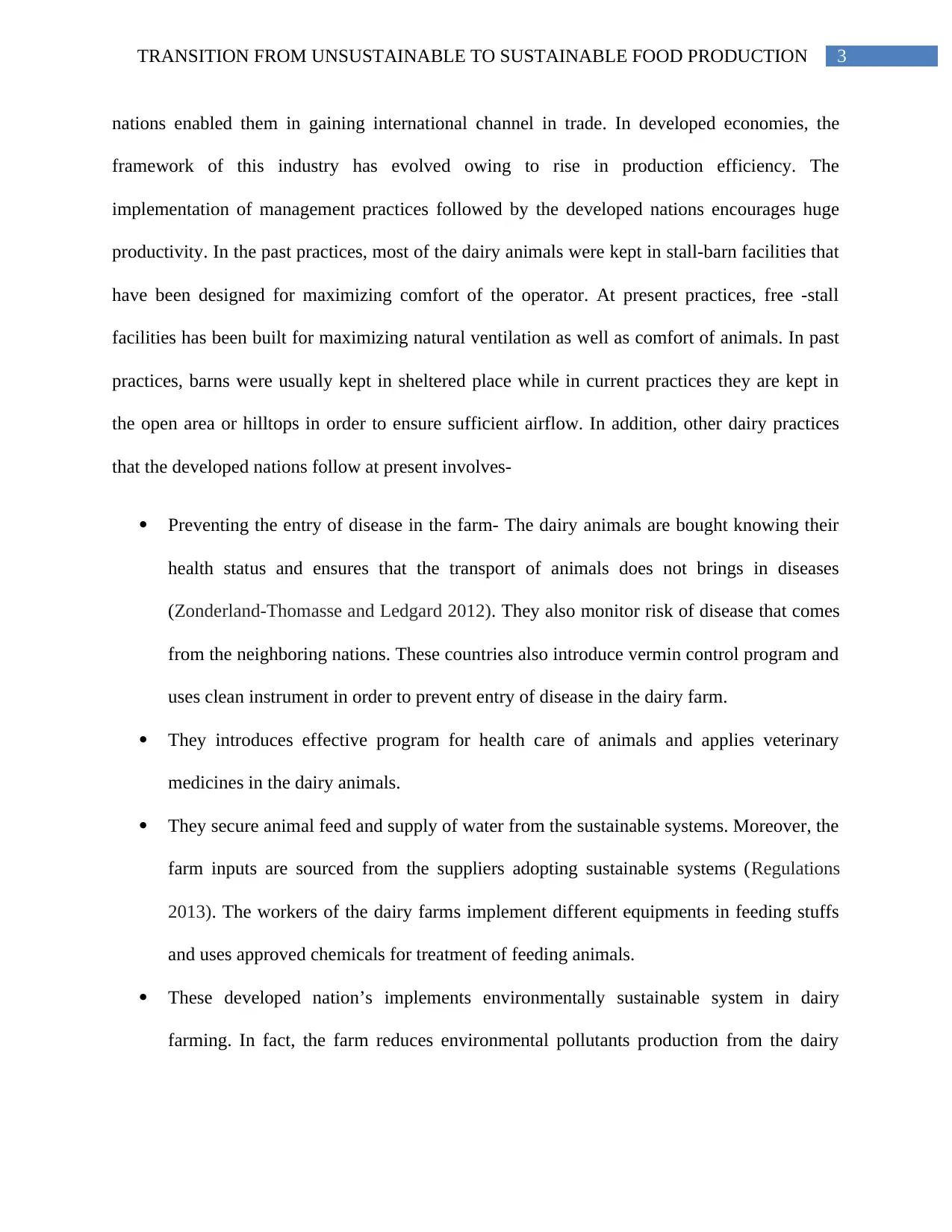
3TRANSITION FROM UNSUSTAINABLE TO SUSTAINABLE FOOD PRODUCTION
nations enabled them in gaining international channel in trade. In developed economies, the
framework of this industry has evolved owing to rise in production efficiency. The
implementation of management practices followed by the developed nations encourages huge
productivity. In the past practices, most of the dairy animals were kept in stall-barn facilities that
have been designed for maximizing comfort of the operator. At present practices, free -stall
facilities has been built for maximizing natural ventilation as well as comfort of animals. In past
practices, barns were usually kept in sheltered place while in current practices they are kept in
the open area or hilltops in order to ensure sufficient airflow. In addition, other dairy practices
that the developed nations follow at present involves-
Preventing the entry of disease in the farm- The dairy animals are bought knowing their
health status and ensures that the transport of animals does not brings in diseases
(Zonderland-Thomasse and Ledgard 2012). They also monitor risk of disease that comes
from the neighboring nations. These countries also introduce vermin control program and
uses clean instrument in order to prevent entry of disease in the dairy farm.
They introduces effective program for health care of animals and applies veterinary
medicines in the dairy animals.
They secure animal feed and supply of water from the sustainable systems. Moreover, the
farm inputs are sourced from the suppliers adopting sustainable systems (Regulations
2013). The workers of the dairy farms implement different equipments in feeding stuffs
and uses approved chemicals for treatment of feeding animals.
These developed nation’s implements environmentally sustainable system in dairy
farming. In fact, the farm reduces environmental pollutants production from the dairy
nations enabled them in gaining international channel in trade. In developed economies, the
framework of this industry has evolved owing to rise in production efficiency. The
implementation of management practices followed by the developed nations encourages huge
productivity. In the past practices, most of the dairy animals were kept in stall-barn facilities that
have been designed for maximizing comfort of the operator. At present practices, free -stall
facilities has been built for maximizing natural ventilation as well as comfort of animals. In past
practices, barns were usually kept in sheltered place while in current practices they are kept in
the open area or hilltops in order to ensure sufficient airflow. In addition, other dairy practices
that the developed nations follow at present involves-
Preventing the entry of disease in the farm- The dairy animals are bought knowing their
health status and ensures that the transport of animals does not brings in diseases
(Zonderland-Thomasse and Ledgard 2012). They also monitor risk of disease that comes
from the neighboring nations. These countries also introduce vermin control program and
uses clean instrument in order to prevent entry of disease in the dairy farm.
They introduces effective program for health care of animals and applies veterinary
medicines in the dairy animals.
They secure animal feed and supply of water from the sustainable systems. Moreover, the
farm inputs are sourced from the suppliers adopting sustainable systems (Regulations
2013). The workers of the dairy farms implement different equipments in feeding stuffs
and uses approved chemicals for treatment of feeding animals.
These developed nation’s implements environmentally sustainable system in dairy
farming. In fact, the farm reduces environmental pollutants production from the dairy
Secure Best Marks with AI Grader
Need help grading? Try our AI Grader for instant feedback on your assignments.
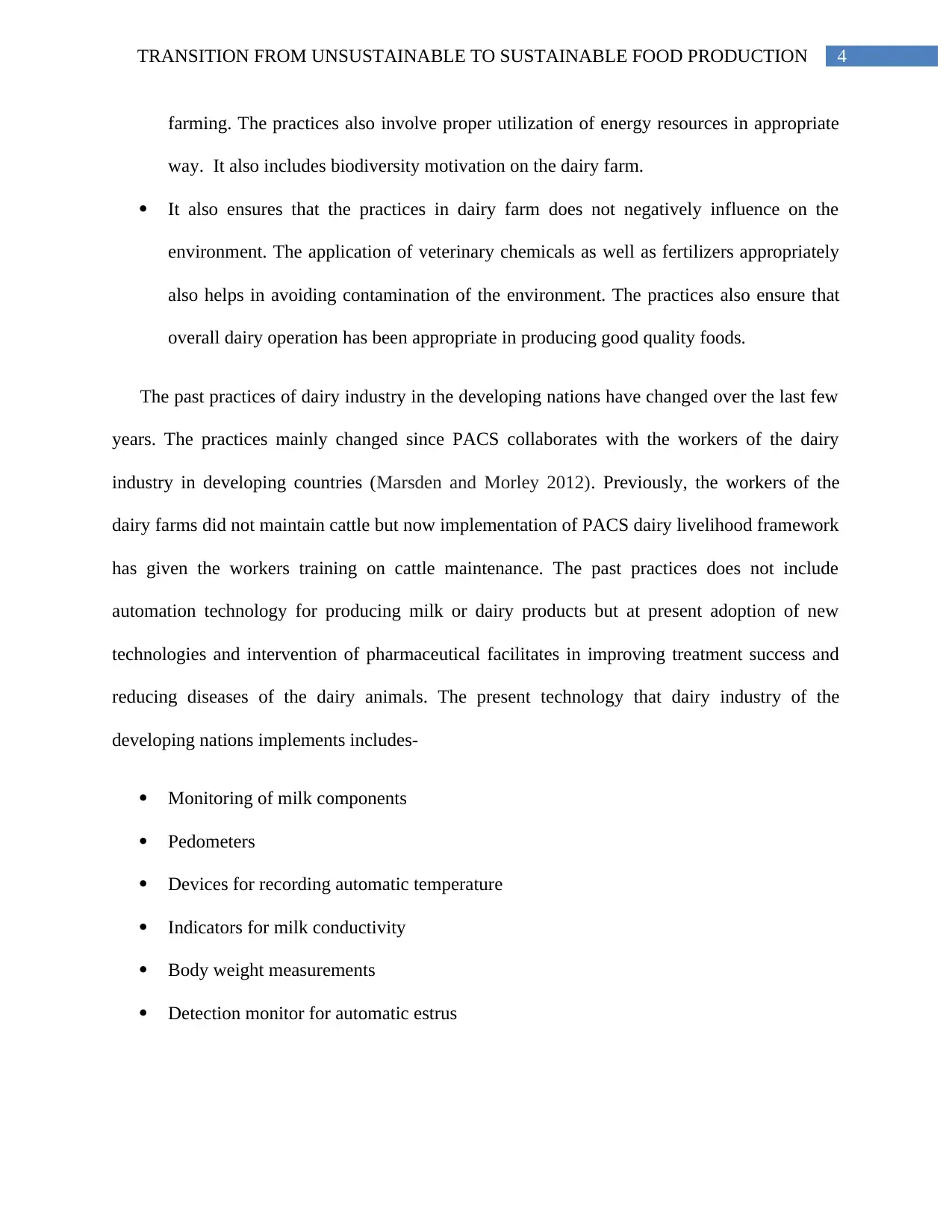
4TRANSITION FROM UNSUSTAINABLE TO SUSTAINABLE FOOD PRODUCTION
farming. The practices also involve proper utilization of energy resources in appropriate
way. It also includes biodiversity motivation on the dairy farm.
It also ensures that the practices in dairy farm does not negatively influence on the
environment. The application of veterinary chemicals as well as fertilizers appropriately
also helps in avoiding contamination of the environment. The practices also ensure that
overall dairy operation has been appropriate in producing good quality foods.
The past practices of dairy industry in the developing nations have changed over the last few
years. The practices mainly changed since PACS collaborates with the workers of the dairy
industry in developing countries (Marsden and Morley 2012). Previously, the workers of the
dairy farms did not maintain cattle but now implementation of PACS dairy livelihood framework
has given the workers training on cattle maintenance. The past practices does not include
automation technology for producing milk or dairy products but at present adoption of new
technologies and intervention of pharmaceutical facilitates in improving treatment success and
reducing diseases of the dairy animals. The present technology that dairy industry of the
developing nations implements includes-
Monitoring of milk components
Pedometers
Devices for recording automatic temperature
Indicators for milk conductivity
Body weight measurements
Detection monitor for automatic estrus
farming. The practices also involve proper utilization of energy resources in appropriate
way. It also includes biodiversity motivation on the dairy farm.
It also ensures that the practices in dairy farm does not negatively influence on the
environment. The application of veterinary chemicals as well as fertilizers appropriately
also helps in avoiding contamination of the environment. The practices also ensure that
overall dairy operation has been appropriate in producing good quality foods.
The past practices of dairy industry in the developing nations have changed over the last few
years. The practices mainly changed since PACS collaborates with the workers of the dairy
industry in developing countries (Marsden and Morley 2012). Previously, the workers of the
dairy farms did not maintain cattle but now implementation of PACS dairy livelihood framework
has given the workers training on cattle maintenance. The past practices does not include
automation technology for producing milk or dairy products but at present adoption of new
technologies and intervention of pharmaceutical facilitates in improving treatment success and
reducing diseases of the dairy animals. The present technology that dairy industry of the
developing nations implements includes-
Monitoring of milk components
Pedometers
Devices for recording automatic temperature
Indicators for milk conductivity
Body weight measurements
Detection monitor for automatic estrus
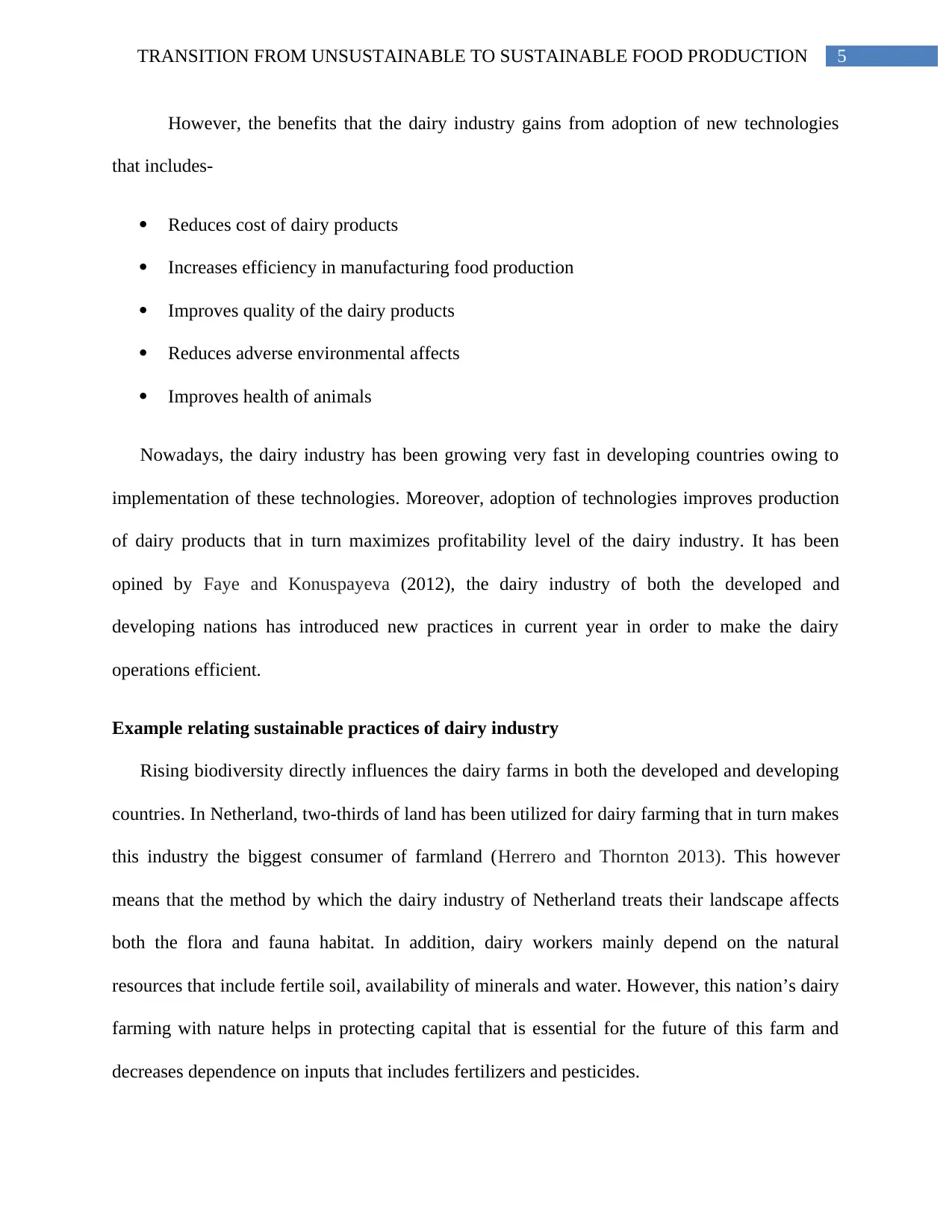
5TRANSITION FROM UNSUSTAINABLE TO SUSTAINABLE FOOD PRODUCTION
However, the benefits that the dairy industry gains from adoption of new technologies
that includes-
Reduces cost of dairy products
Increases efficiency in manufacturing food production
Improves quality of the dairy products
Reduces adverse environmental affects
Improves health of animals
Nowadays, the dairy industry has been growing very fast in developing countries owing to
implementation of these technologies. Moreover, adoption of technologies improves production
of dairy products that in turn maximizes profitability level of the dairy industry. It has been
opined by Faye and Konuspayeva (2012), the dairy industry of both the developed and
developing nations has introduced new practices in current year in order to make the dairy
operations efficient.
Example relating sustainable practices of dairy industry
Rising biodiversity directly influences the dairy farms in both the developed and developing
countries. In Netherland, two-thirds of land has been utilized for dairy farming that in turn makes
this industry the biggest consumer of farmland (Herrero and Thornton 2013). This however
means that the method by which the dairy industry of Netherland treats their landscape affects
both the flora and fauna habitat. In addition, dairy workers mainly depend on the natural
resources that include fertile soil, availability of minerals and water. However, this nation’s dairy
farming with nature helps in protecting capital that is essential for the future of this farm and
decreases dependence on inputs that includes fertilizers and pesticides.
However, the benefits that the dairy industry gains from adoption of new technologies
that includes-
Reduces cost of dairy products
Increases efficiency in manufacturing food production
Improves quality of the dairy products
Reduces adverse environmental affects
Improves health of animals
Nowadays, the dairy industry has been growing very fast in developing countries owing to
implementation of these technologies. Moreover, adoption of technologies improves production
of dairy products that in turn maximizes profitability level of the dairy industry. It has been
opined by Faye and Konuspayeva (2012), the dairy industry of both the developed and
developing nations has introduced new practices in current year in order to make the dairy
operations efficient.
Example relating sustainable practices of dairy industry
Rising biodiversity directly influences the dairy farms in both the developed and developing
countries. In Netherland, two-thirds of land has been utilized for dairy farming that in turn makes
this industry the biggest consumer of farmland (Herrero and Thornton 2013). This however
means that the method by which the dairy industry of Netherland treats their landscape affects
both the flora and fauna habitat. In addition, dairy workers mainly depend on the natural
resources that include fertile soil, availability of minerals and water. However, this nation’s dairy
farming with nature helps in protecting capital that is essential for the future of this farm and
decreases dependence on inputs that includes fertilizers and pesticides.
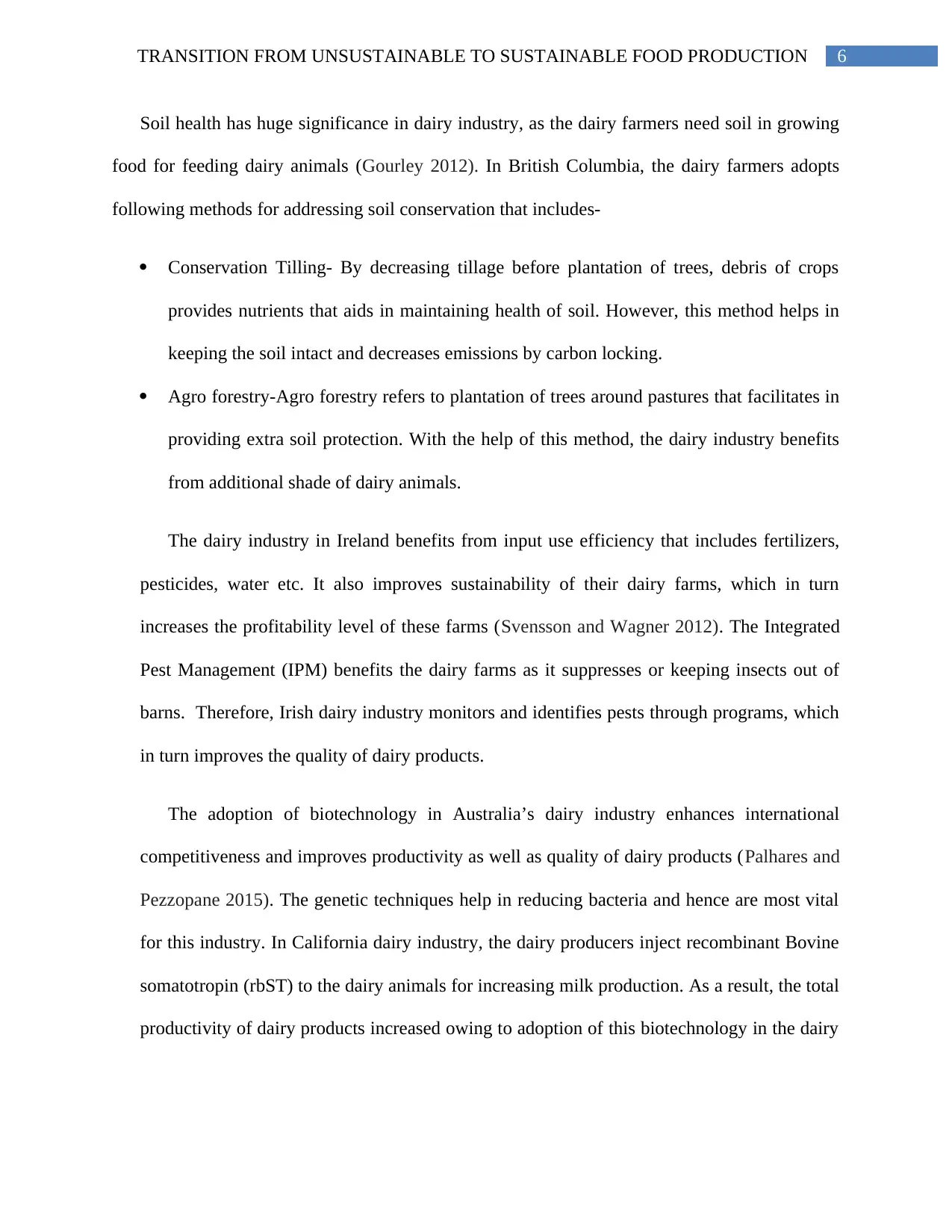
6TRANSITION FROM UNSUSTAINABLE TO SUSTAINABLE FOOD PRODUCTION
Soil health has huge significance in dairy industry, as the dairy farmers need soil in growing
food for feeding dairy animals (Gourley 2012). In British Columbia, the dairy farmers adopts
following methods for addressing soil conservation that includes-
Conservation Tilling- By decreasing tillage before plantation of trees, debris of crops
provides nutrients that aids in maintaining health of soil. However, this method helps in
keeping the soil intact and decreases emissions by carbon locking.
Agro forestry-Agro forestry refers to plantation of trees around pastures that facilitates in
providing extra soil protection. With the help of this method, the dairy industry benefits
from additional shade of dairy animals.
The dairy industry in Ireland benefits from input use efficiency that includes fertilizers,
pesticides, water etc. It also improves sustainability of their dairy farms, which in turn
increases the profitability level of these farms (Svensson and Wagner 2012). The Integrated
Pest Management (IPM) benefits the dairy farms as it suppresses or keeping insects out of
barns. Therefore, Irish dairy industry monitors and identifies pests through programs, which
in turn improves the quality of dairy products.
The adoption of biotechnology in Australia’s dairy industry enhances international
competitiveness and improves productivity as well as quality of dairy products (Palhares and
Pezzopane 2015). The genetic techniques help in reducing bacteria and hence are most vital
for this industry. In California dairy industry, the dairy producers inject recombinant Bovine
somatotropin (rbST) to the dairy animals for increasing milk production. As a result, the total
productivity of dairy products increased owing to adoption of this biotechnology in the dairy
Soil health has huge significance in dairy industry, as the dairy farmers need soil in growing
food for feeding dairy animals (Gourley 2012). In British Columbia, the dairy farmers adopts
following methods for addressing soil conservation that includes-
Conservation Tilling- By decreasing tillage before plantation of trees, debris of crops
provides nutrients that aids in maintaining health of soil. However, this method helps in
keeping the soil intact and decreases emissions by carbon locking.
Agro forestry-Agro forestry refers to plantation of trees around pastures that facilitates in
providing extra soil protection. With the help of this method, the dairy industry benefits
from additional shade of dairy animals.
The dairy industry in Ireland benefits from input use efficiency that includes fertilizers,
pesticides, water etc. It also improves sustainability of their dairy farms, which in turn
increases the profitability level of these farms (Svensson and Wagner 2012). The Integrated
Pest Management (IPM) benefits the dairy farms as it suppresses or keeping insects out of
barns. Therefore, Irish dairy industry monitors and identifies pests through programs, which
in turn improves the quality of dairy products.
The adoption of biotechnology in Australia’s dairy industry enhances international
competitiveness and improves productivity as well as quality of dairy products (Palhares and
Pezzopane 2015). The genetic techniques help in reducing bacteria and hence are most vital
for this industry. In California dairy industry, the dairy producers inject recombinant Bovine
somatotropin (rbST) to the dairy animals for increasing milk production. As a result, the total
productivity of dairy products increased owing to adoption of this biotechnology in the dairy
Paraphrase This Document
Need a fresh take? Get an instant paraphrase of this document with our AI Paraphraser
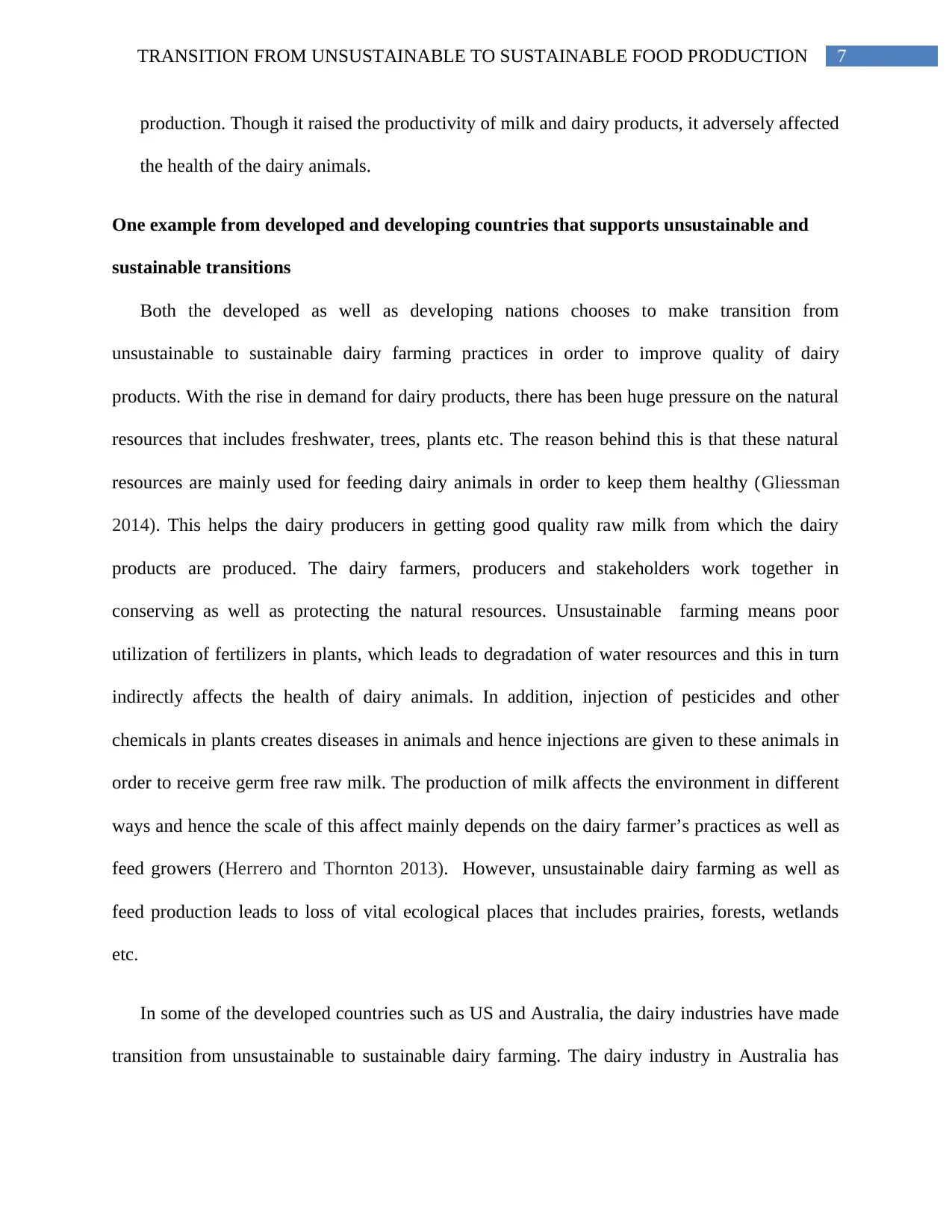
7TRANSITION FROM UNSUSTAINABLE TO SUSTAINABLE FOOD PRODUCTION
production. Though it raised the productivity of milk and dairy products, it adversely affected
the health of the dairy animals.
One example from developed and developing countries that supports unsustainable and
sustainable transitions
Both the developed as well as developing nations chooses to make transition from
unsustainable to sustainable dairy farming practices in order to improve quality of dairy
products. With the rise in demand for dairy products, there has been huge pressure on the natural
resources that includes freshwater, trees, plants etc. The reason behind this is that these natural
resources are mainly used for feeding dairy animals in order to keep them healthy (Gliessman
2014). This helps the dairy producers in getting good quality raw milk from which the dairy
products are produced. The dairy farmers, producers and stakeholders work together in
conserving as well as protecting the natural resources. Unsustainable farming means poor
utilization of fertilizers in plants, which leads to degradation of water resources and this in turn
indirectly affects the health of dairy animals. In addition, injection of pesticides and other
chemicals in plants creates diseases in animals and hence injections are given to these animals in
order to receive germ free raw milk. The production of milk affects the environment in different
ways and hence the scale of this affect mainly depends on the dairy farmer’s practices as well as
feed growers (Herrero and Thornton 2013). However, unsustainable dairy farming as well as
feed production leads to loss of vital ecological places that includes prairies, forests, wetlands
etc.
In some of the developed countries such as US and Australia, the dairy industries have made
transition from unsustainable to sustainable dairy farming. The dairy industry in Australia has
production. Though it raised the productivity of milk and dairy products, it adversely affected
the health of the dairy animals.
One example from developed and developing countries that supports unsustainable and
sustainable transitions
Both the developed as well as developing nations chooses to make transition from
unsustainable to sustainable dairy farming practices in order to improve quality of dairy
products. With the rise in demand for dairy products, there has been huge pressure on the natural
resources that includes freshwater, trees, plants etc. The reason behind this is that these natural
resources are mainly used for feeding dairy animals in order to keep them healthy (Gliessman
2014). This helps the dairy producers in getting good quality raw milk from which the dairy
products are produced. The dairy farmers, producers and stakeholders work together in
conserving as well as protecting the natural resources. Unsustainable farming means poor
utilization of fertilizers in plants, which leads to degradation of water resources and this in turn
indirectly affects the health of dairy animals. In addition, injection of pesticides and other
chemicals in plants creates diseases in animals and hence injections are given to these animals in
order to receive germ free raw milk. The production of milk affects the environment in different
ways and hence the scale of this affect mainly depends on the dairy farmer’s practices as well as
feed growers (Herrero and Thornton 2013). However, unsustainable dairy farming as well as
feed production leads to loss of vital ecological places that includes prairies, forests, wetlands
etc.
In some of the developed countries such as US and Australia, the dairy industries have made
transition from unsustainable to sustainable dairy farming. The dairy industry in Australia has
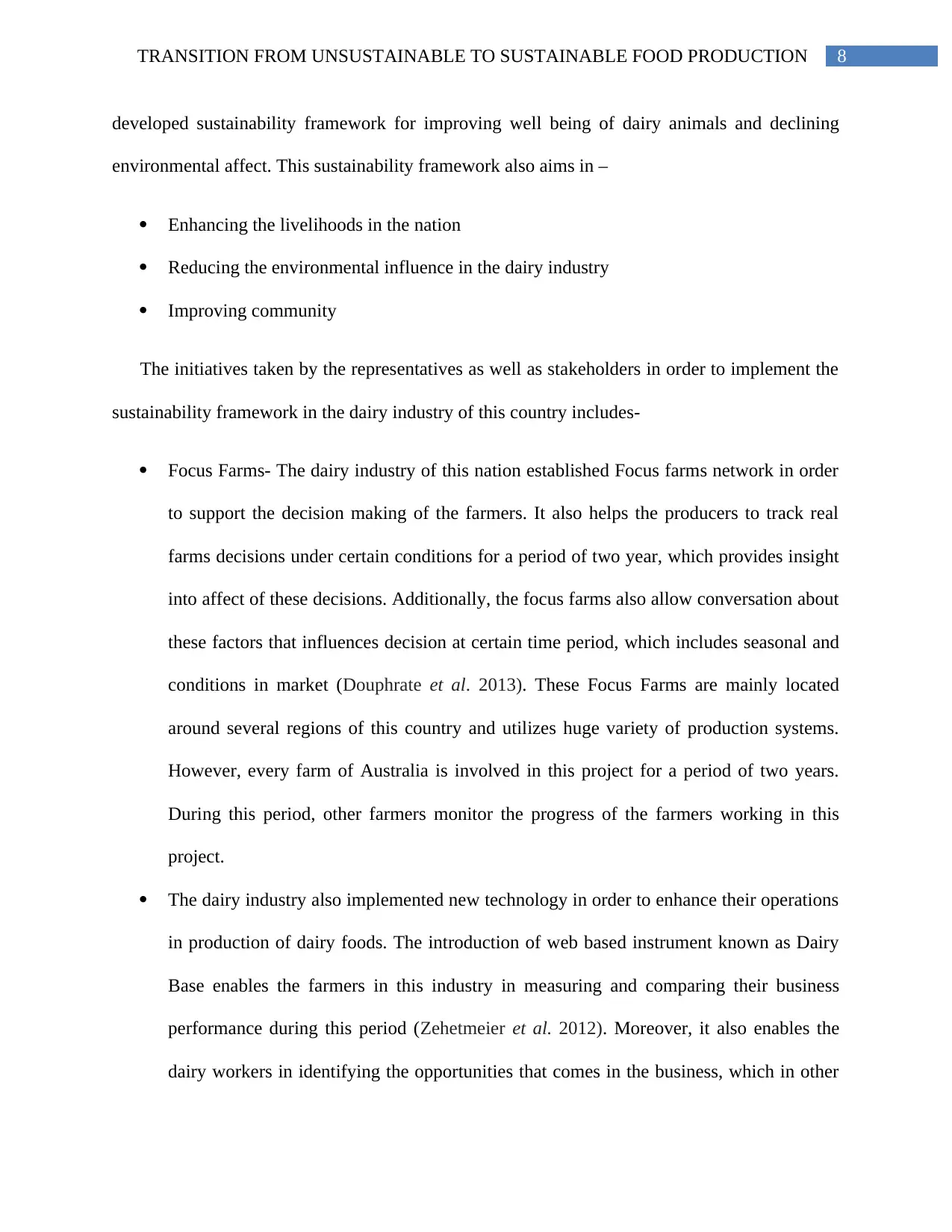
8TRANSITION FROM UNSUSTAINABLE TO SUSTAINABLE FOOD PRODUCTION
developed sustainability framework for improving well being of dairy animals and declining
environmental affect. This sustainability framework also aims in –
Enhancing the livelihoods in the nation
Reducing the environmental influence in the dairy industry
Improving community
The initiatives taken by the representatives as well as stakeholders in order to implement the
sustainability framework in the dairy industry of this country includes-
Focus Farms- The dairy industry of this nation established Focus farms network in order
to support the decision making of the farmers. It also helps the producers to track real
farms decisions under certain conditions for a period of two year, which provides insight
into affect of these decisions. Additionally, the focus farms also allow conversation about
these factors that influences decision at certain time period, which includes seasonal and
conditions in market (Douphrate et al. 2013). These Focus Farms are mainly located
around several regions of this country and utilizes huge variety of production systems.
However, every farm of Australia is involved in this project for a period of two years.
During this period, other farmers monitor the progress of the farmers working in this
project.
The dairy industry also implemented new technology in order to enhance their operations
in production of dairy foods. The introduction of web based instrument known as Dairy
Base enables the farmers in this industry in measuring and comparing their business
performance during this period (Zehetmeier et al. 2012). Moreover, it also enables the
dairy workers in identifying the opportunities that comes in the business, which in other
developed sustainability framework for improving well being of dairy animals and declining
environmental affect. This sustainability framework also aims in –
Enhancing the livelihoods in the nation
Reducing the environmental influence in the dairy industry
Improving community
The initiatives taken by the representatives as well as stakeholders in order to implement the
sustainability framework in the dairy industry of this country includes-
Focus Farms- The dairy industry of this nation established Focus farms network in order
to support the decision making of the farmers. It also helps the producers to track real
farms decisions under certain conditions for a period of two year, which provides insight
into affect of these decisions. Additionally, the focus farms also allow conversation about
these factors that influences decision at certain time period, which includes seasonal and
conditions in market (Douphrate et al. 2013). These Focus Farms are mainly located
around several regions of this country and utilizes huge variety of production systems.
However, every farm of Australia is involved in this project for a period of two years.
During this period, other farmers monitor the progress of the farmers working in this
project.
The dairy industry also implemented new technology in order to enhance their operations
in production of dairy foods. The introduction of web based instrument known as Dairy
Base enables the farmers in this industry in measuring and comparing their business
performance during this period (Zehetmeier et al. 2012). Moreover, it also enables the
dairy workers in identifying the opportunities that comes in the business, which in other
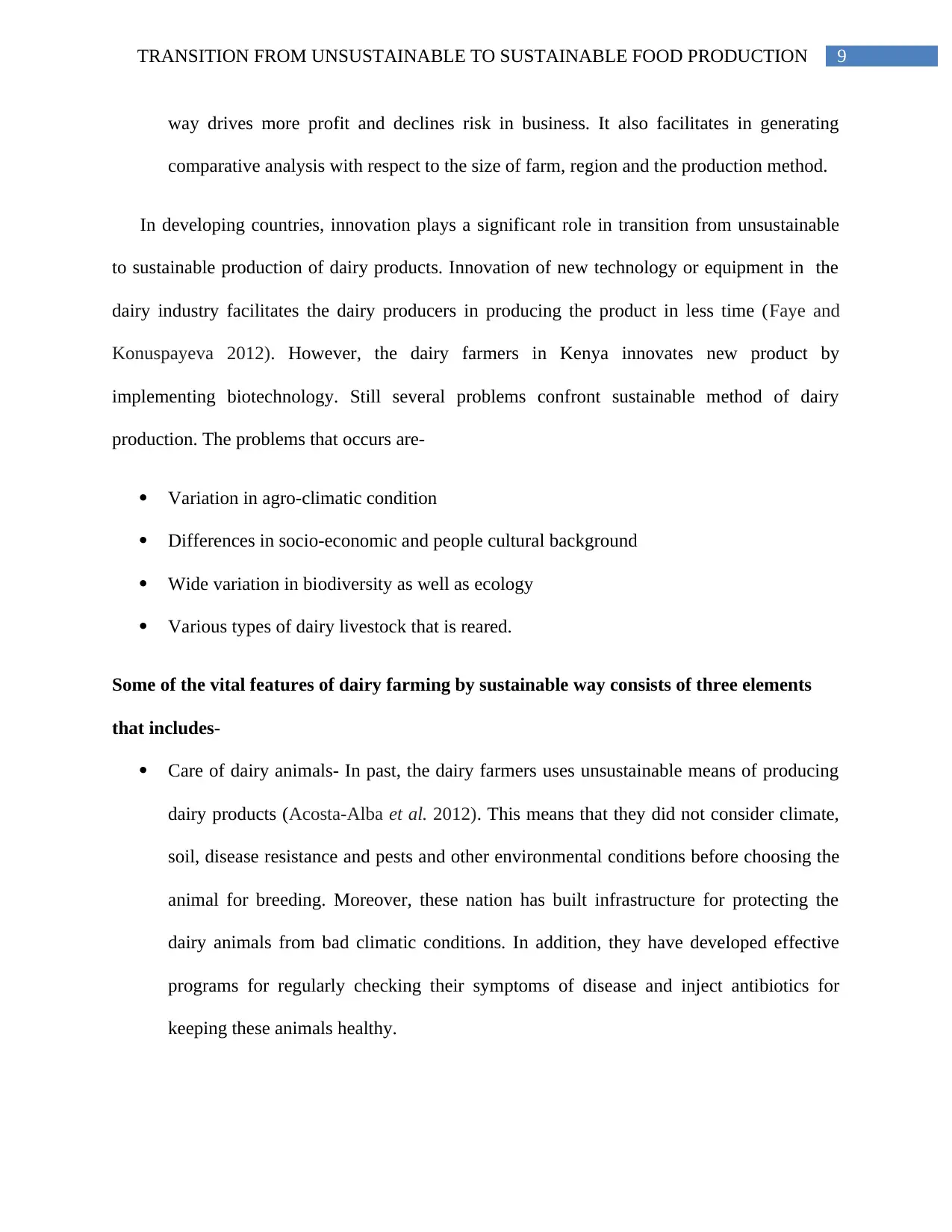
9TRANSITION FROM UNSUSTAINABLE TO SUSTAINABLE FOOD PRODUCTION
way drives more profit and declines risk in business. It also facilitates in generating
comparative analysis with respect to the size of farm, region and the production method.
In developing countries, innovation plays a significant role in transition from unsustainable
to sustainable production of dairy products. Innovation of new technology or equipment in the
dairy industry facilitates the dairy producers in producing the product in less time (Faye and
Konuspayeva 2012). However, the dairy farmers in Kenya innovates new product by
implementing biotechnology. Still several problems confront sustainable method of dairy
production. The problems that occurs are-
Variation in agro-climatic condition
Differences in socio-economic and people cultural background
Wide variation in biodiversity as well as ecology
Various types of dairy livestock that is reared.
Some of the vital features of dairy farming by sustainable way consists of three elements
that includes-
Care of dairy animals- In past, the dairy farmers uses unsustainable means of producing
dairy products (Acosta-Alba et al. 2012). This means that they did not consider climate,
soil, disease resistance and pests and other environmental conditions before choosing the
animal for breeding. Moreover, these nation has built infrastructure for protecting the
dairy animals from bad climatic conditions. In addition, they have developed effective
programs for regularly checking their symptoms of disease and inject antibiotics for
keeping these animals healthy.
way drives more profit and declines risk in business. It also facilitates in generating
comparative analysis with respect to the size of farm, region and the production method.
In developing countries, innovation plays a significant role in transition from unsustainable
to sustainable production of dairy products. Innovation of new technology or equipment in the
dairy industry facilitates the dairy producers in producing the product in less time (Faye and
Konuspayeva 2012). However, the dairy farmers in Kenya innovates new product by
implementing biotechnology. Still several problems confront sustainable method of dairy
production. The problems that occurs are-
Variation in agro-climatic condition
Differences in socio-economic and people cultural background
Wide variation in biodiversity as well as ecology
Various types of dairy livestock that is reared.
Some of the vital features of dairy farming by sustainable way consists of three elements
that includes-
Care of dairy animals- In past, the dairy farmers uses unsustainable means of producing
dairy products (Acosta-Alba et al. 2012). This means that they did not consider climate,
soil, disease resistance and pests and other environmental conditions before choosing the
animal for breeding. Moreover, these nation has built infrastructure for protecting the
dairy animals from bad climatic conditions. In addition, they have developed effective
programs for regularly checking their symptoms of disease and inject antibiotics for
keeping these animals healthy.
Secure Best Marks with AI Grader
Need help grading? Try our AI Grader for instant feedback on your assignments.
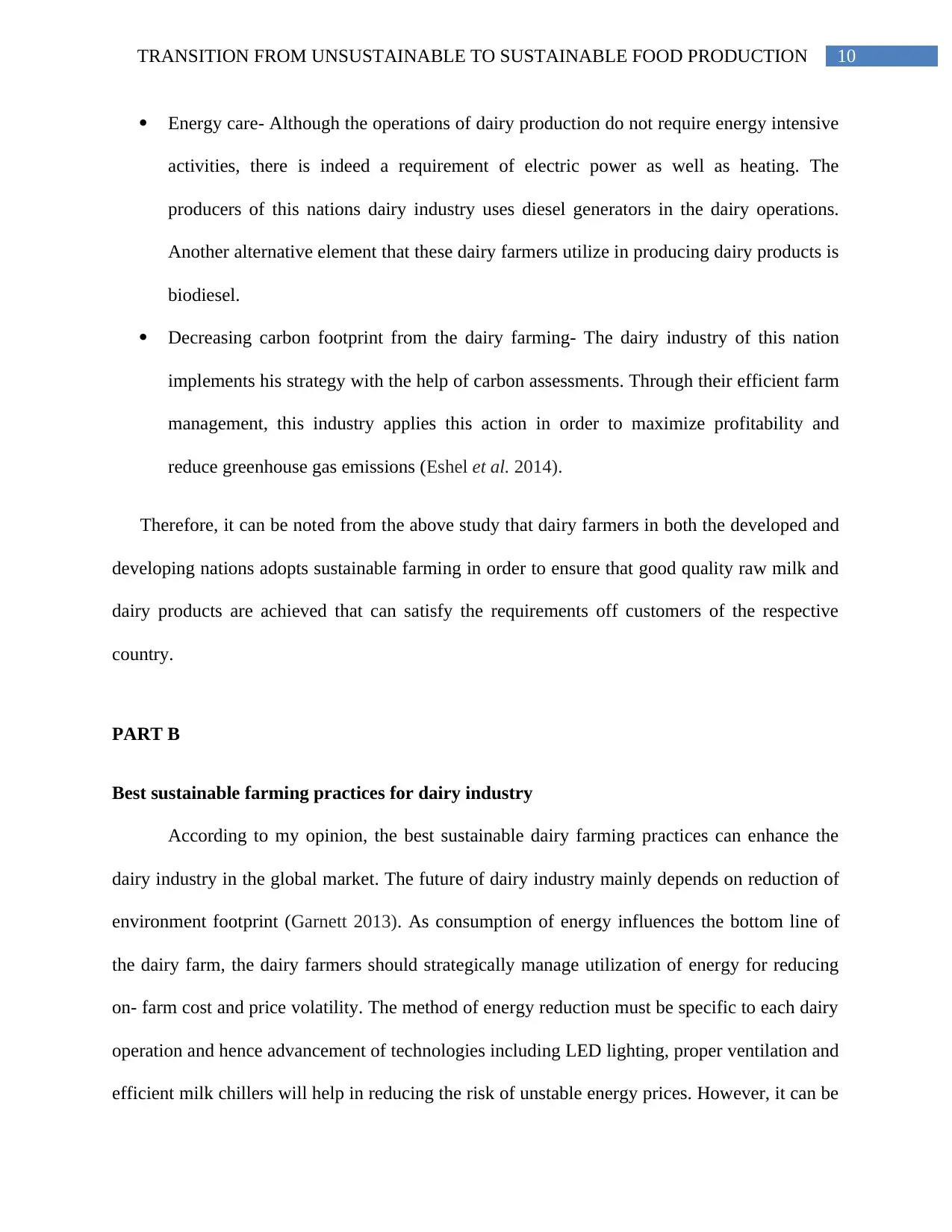
10TRANSITION FROM UNSUSTAINABLE TO SUSTAINABLE FOOD PRODUCTION
Energy care- Although the operations of dairy production do not require energy intensive
activities, there is indeed a requirement of electric power as well as heating. The
producers of this nations dairy industry uses diesel generators in the dairy operations.
Another alternative element that these dairy farmers utilize in producing dairy products is
biodiesel.
Decreasing carbon footprint from the dairy farming- The dairy industry of this nation
implements his strategy with the help of carbon assessments. Through their efficient farm
management, this industry applies this action in order to maximize profitability and
reduce greenhouse gas emissions (Eshel et al. 2014).
Therefore, it can be noted from the above study that dairy farmers in both the developed and
developing nations adopts sustainable farming in order to ensure that good quality raw milk and
dairy products are achieved that can satisfy the requirements off customers of the respective
country.
PART B
Best sustainable farming practices for dairy industry
According to my opinion, the best sustainable dairy farming practices can enhance the
dairy industry in the global market. The future of dairy industry mainly depends on reduction of
environment footprint (Garnett 2013). As consumption of energy influences the bottom line of
the dairy farm, the dairy farmers should strategically manage utilization of energy for reducing
on- farm cost and price volatility. The method of energy reduction must be specific to each dairy
operation and hence advancement of technologies including LED lighting, proper ventilation and
efficient milk chillers will help in reducing the risk of unstable energy prices. However, it can be
Energy care- Although the operations of dairy production do not require energy intensive
activities, there is indeed a requirement of electric power as well as heating. The
producers of this nations dairy industry uses diesel generators in the dairy operations.
Another alternative element that these dairy farmers utilize in producing dairy products is
biodiesel.
Decreasing carbon footprint from the dairy farming- The dairy industry of this nation
implements his strategy with the help of carbon assessments. Through their efficient farm
management, this industry applies this action in order to maximize profitability and
reduce greenhouse gas emissions (Eshel et al. 2014).
Therefore, it can be noted from the above study that dairy farmers in both the developed and
developing nations adopts sustainable farming in order to ensure that good quality raw milk and
dairy products are achieved that can satisfy the requirements off customers of the respective
country.
PART B
Best sustainable farming practices for dairy industry
According to my opinion, the best sustainable dairy farming practices can enhance the
dairy industry in the global market. The future of dairy industry mainly depends on reduction of
environment footprint (Garnett 2013). As consumption of energy influences the bottom line of
the dairy farm, the dairy farmers should strategically manage utilization of energy for reducing
on- farm cost and price volatility. The method of energy reduction must be specific to each dairy
operation and hence advancement of technologies including LED lighting, proper ventilation and
efficient milk chillers will help in reducing the risk of unstable energy prices. However, it can be
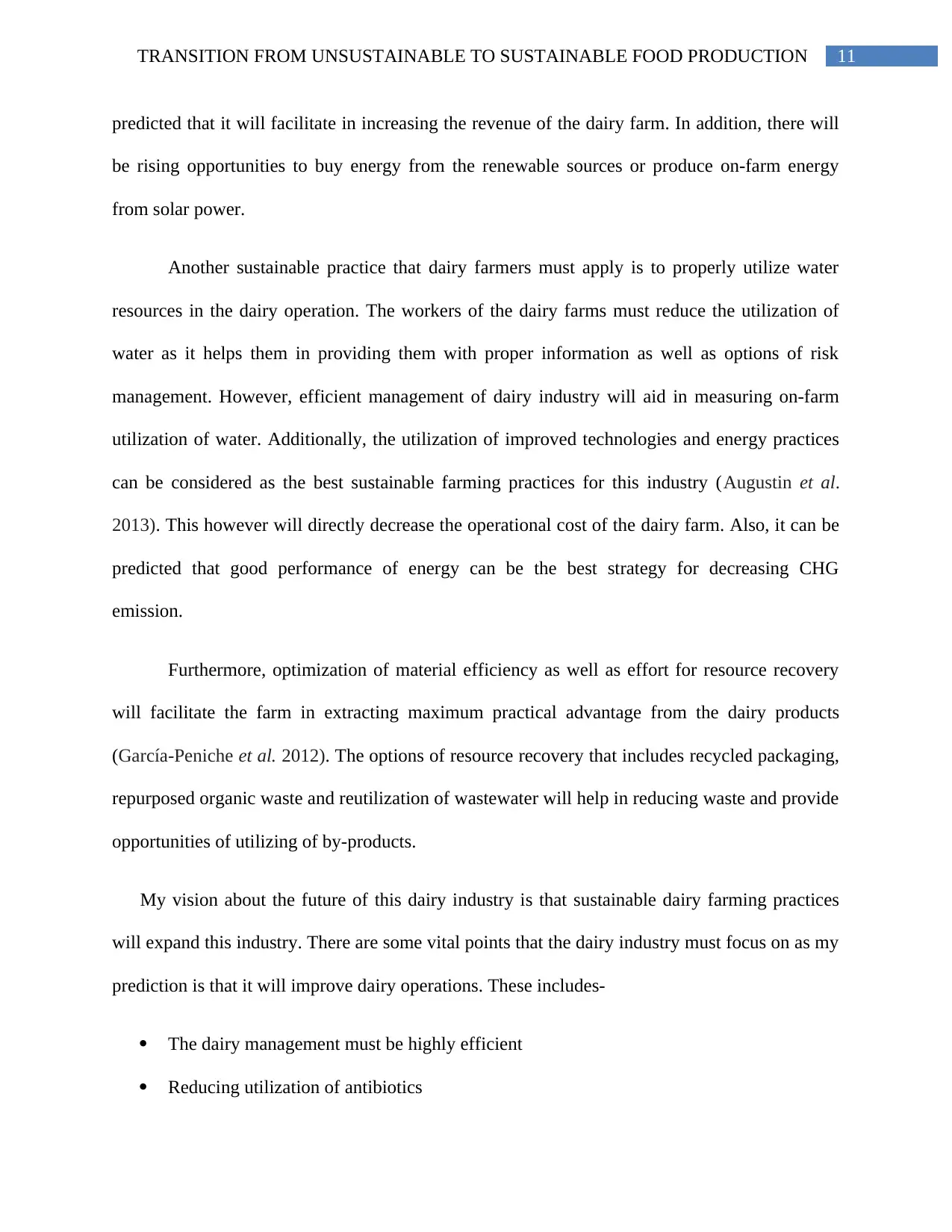
11TRANSITION FROM UNSUSTAINABLE TO SUSTAINABLE FOOD PRODUCTION
predicted that it will facilitate in increasing the revenue of the dairy farm. In addition, there will
be rising opportunities to buy energy from the renewable sources or produce on-farm energy
from solar power.
Another sustainable practice that dairy farmers must apply is to properly utilize water
resources in the dairy operation. The workers of the dairy farms must reduce the utilization of
water as it helps them in providing them with proper information as well as options of risk
management. However, efficient management of dairy industry will aid in measuring on-farm
utilization of water. Additionally, the utilization of improved technologies and energy practices
can be considered as the best sustainable farming practices for this industry (Augustin et al.
2013). This however will directly decrease the operational cost of the dairy farm. Also, it can be
predicted that good performance of energy can be the best strategy for decreasing CHG
emission.
Furthermore, optimization of material efficiency as well as effort for resource recovery
will facilitate the farm in extracting maximum practical advantage from the dairy products
(García-Peniche et al. 2012). The options of resource recovery that includes recycled packaging,
repurposed organic waste and reutilization of wastewater will help in reducing waste and provide
opportunities of utilizing of by-products.
My vision about the future of this dairy industry is that sustainable dairy farming practices
will expand this industry. There are some vital points that the dairy industry must focus on as my
prediction is that it will improve dairy operations. These includes-
The dairy management must be highly efficient
Reducing utilization of antibiotics
predicted that it will facilitate in increasing the revenue of the dairy farm. In addition, there will
be rising opportunities to buy energy from the renewable sources or produce on-farm energy
from solar power.
Another sustainable practice that dairy farmers must apply is to properly utilize water
resources in the dairy operation. The workers of the dairy farms must reduce the utilization of
water as it helps them in providing them with proper information as well as options of risk
management. However, efficient management of dairy industry will aid in measuring on-farm
utilization of water. Additionally, the utilization of improved technologies and energy practices
can be considered as the best sustainable farming practices for this industry (Augustin et al.
2013). This however will directly decrease the operational cost of the dairy farm. Also, it can be
predicted that good performance of energy can be the best strategy for decreasing CHG
emission.
Furthermore, optimization of material efficiency as well as effort for resource recovery
will facilitate the farm in extracting maximum practical advantage from the dairy products
(García-Peniche et al. 2012). The options of resource recovery that includes recycled packaging,
repurposed organic waste and reutilization of wastewater will help in reducing waste and provide
opportunities of utilizing of by-products.
My vision about the future of this dairy industry is that sustainable dairy farming practices
will expand this industry. There are some vital points that the dairy industry must focus on as my
prediction is that it will improve dairy operations. These includes-
The dairy management must be highly efficient
Reducing utilization of antibiotics
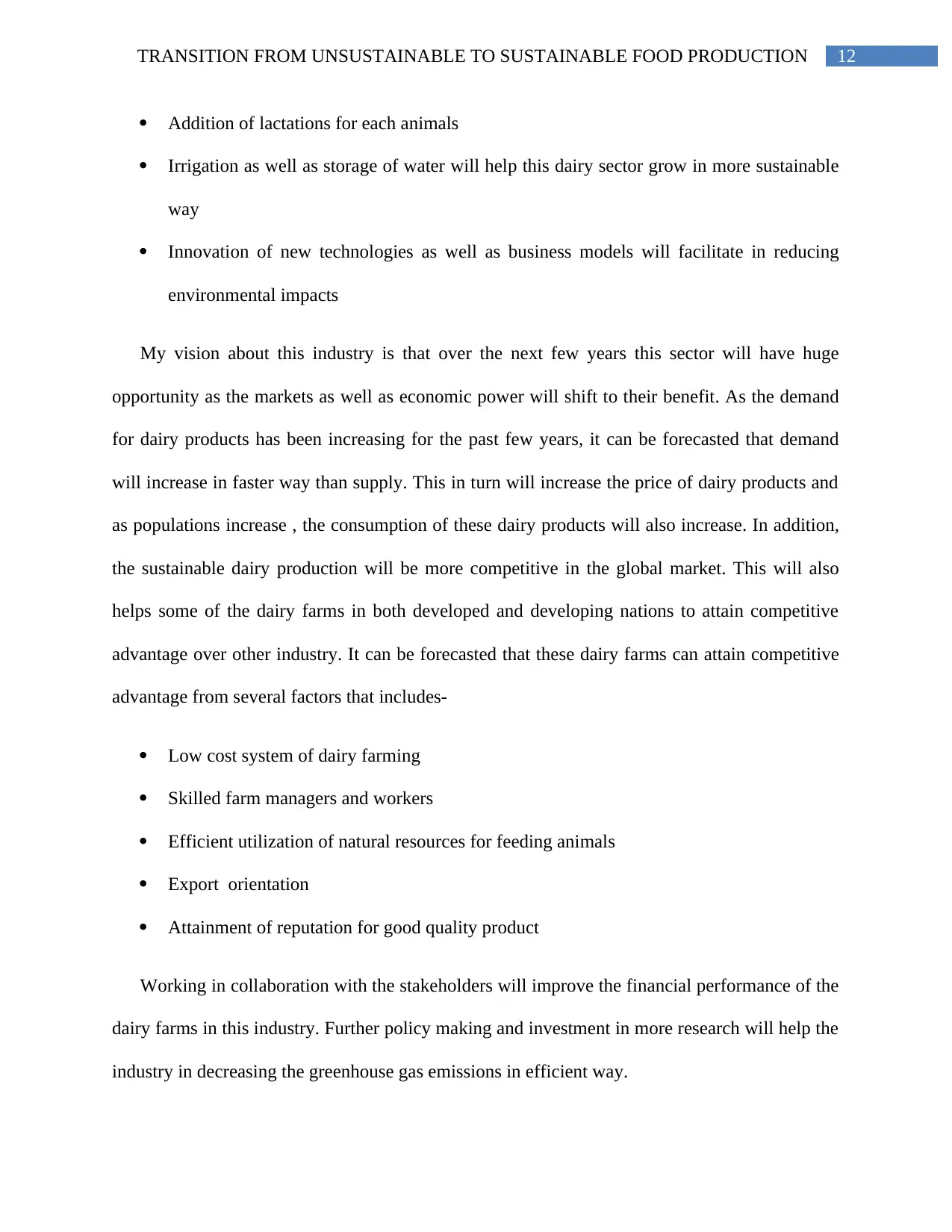
12TRANSITION FROM UNSUSTAINABLE TO SUSTAINABLE FOOD PRODUCTION
Addition of lactations for each animals
Irrigation as well as storage of water will help this dairy sector grow in more sustainable
way
Innovation of new technologies as well as business models will facilitate in reducing
environmental impacts
My vision about this industry is that over the next few years this sector will have huge
opportunity as the markets as well as economic power will shift to their benefit. As the demand
for dairy products has been increasing for the past few years, it can be forecasted that demand
will increase in faster way than supply. This in turn will increase the price of dairy products and
as populations increase , the consumption of these dairy products will also increase. In addition,
the sustainable dairy production will be more competitive in the global market. This will also
helps some of the dairy farms in both developed and developing nations to attain competitive
advantage over other industry. It can be forecasted that these dairy farms can attain competitive
advantage from several factors that includes-
Low cost system of dairy farming
Skilled farm managers and workers
Efficient utilization of natural resources for feeding animals
Export orientation
Attainment of reputation for good quality product
Working in collaboration with the stakeholders will improve the financial performance of the
dairy farms in this industry. Further policy making and investment in more research will help the
industry in decreasing the greenhouse gas emissions in efficient way.
Addition of lactations for each animals
Irrigation as well as storage of water will help this dairy sector grow in more sustainable
way
Innovation of new technologies as well as business models will facilitate in reducing
environmental impacts
My vision about this industry is that over the next few years this sector will have huge
opportunity as the markets as well as economic power will shift to their benefit. As the demand
for dairy products has been increasing for the past few years, it can be forecasted that demand
will increase in faster way than supply. This in turn will increase the price of dairy products and
as populations increase , the consumption of these dairy products will also increase. In addition,
the sustainable dairy production will be more competitive in the global market. This will also
helps some of the dairy farms in both developed and developing nations to attain competitive
advantage over other industry. It can be forecasted that these dairy farms can attain competitive
advantage from several factors that includes-
Low cost system of dairy farming
Skilled farm managers and workers
Efficient utilization of natural resources for feeding animals
Export orientation
Attainment of reputation for good quality product
Working in collaboration with the stakeholders will improve the financial performance of the
dairy farms in this industry. Further policy making and investment in more research will help the
industry in decreasing the greenhouse gas emissions in efficient way.
Paraphrase This Document
Need a fresh take? Get an instant paraphrase of this document with our AI Paraphraser
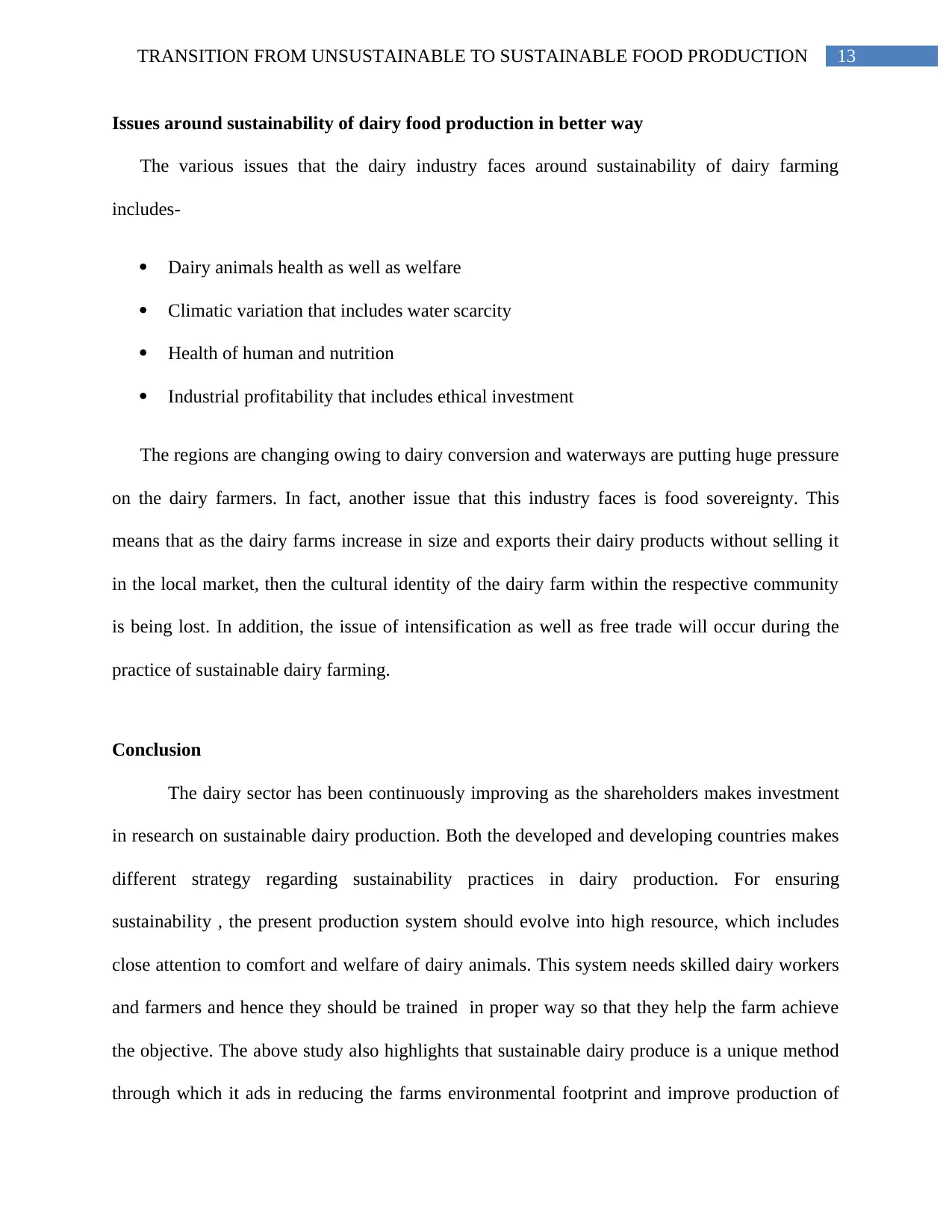
13TRANSITION FROM UNSUSTAINABLE TO SUSTAINABLE FOOD PRODUCTION
Issues around sustainability of dairy food production in better way
The various issues that the dairy industry faces around sustainability of dairy farming
includes-
Dairy animals health as well as welfare
Climatic variation that includes water scarcity
Health of human and nutrition
Industrial profitability that includes ethical investment
The regions are changing owing to dairy conversion and waterways are putting huge pressure
on the dairy farmers. In fact, another issue that this industry faces is food sovereignty. This
means that as the dairy farms increase in size and exports their dairy products without selling it
in the local market, then the cultural identity of the dairy farm within the respective community
is being lost. In addition, the issue of intensification as well as free trade will occur during the
practice of sustainable dairy farming.
Conclusion
The dairy sector has been continuously improving as the shareholders makes investment
in research on sustainable dairy production. Both the developed and developing countries makes
different strategy regarding sustainability practices in dairy production. For ensuring
sustainability , the present production system should evolve into high resource, which includes
close attention to comfort and welfare of dairy animals. This system needs skilled dairy workers
and farmers and hence they should be trained in proper way so that they help the farm achieve
the objective. The above study also highlights that sustainable dairy produce is a unique method
through which it ads in reducing the farms environmental footprint and improve production of
Issues around sustainability of dairy food production in better way
The various issues that the dairy industry faces around sustainability of dairy farming
includes-
Dairy animals health as well as welfare
Climatic variation that includes water scarcity
Health of human and nutrition
Industrial profitability that includes ethical investment
The regions are changing owing to dairy conversion and waterways are putting huge pressure
on the dairy farmers. In fact, another issue that this industry faces is food sovereignty. This
means that as the dairy farms increase in size and exports their dairy products without selling it
in the local market, then the cultural identity of the dairy farm within the respective community
is being lost. In addition, the issue of intensification as well as free trade will occur during the
practice of sustainable dairy farming.
Conclusion
The dairy sector has been continuously improving as the shareholders makes investment
in research on sustainable dairy production. Both the developed and developing countries makes
different strategy regarding sustainability practices in dairy production. For ensuring
sustainability , the present production system should evolve into high resource, which includes
close attention to comfort and welfare of dairy animals. This system needs skilled dairy workers
and farmers and hence they should be trained in proper way so that they help the farm achieve
the objective. The above study also highlights that sustainable dairy produce is a unique method
through which it ads in reducing the farms environmental footprint and improve production of
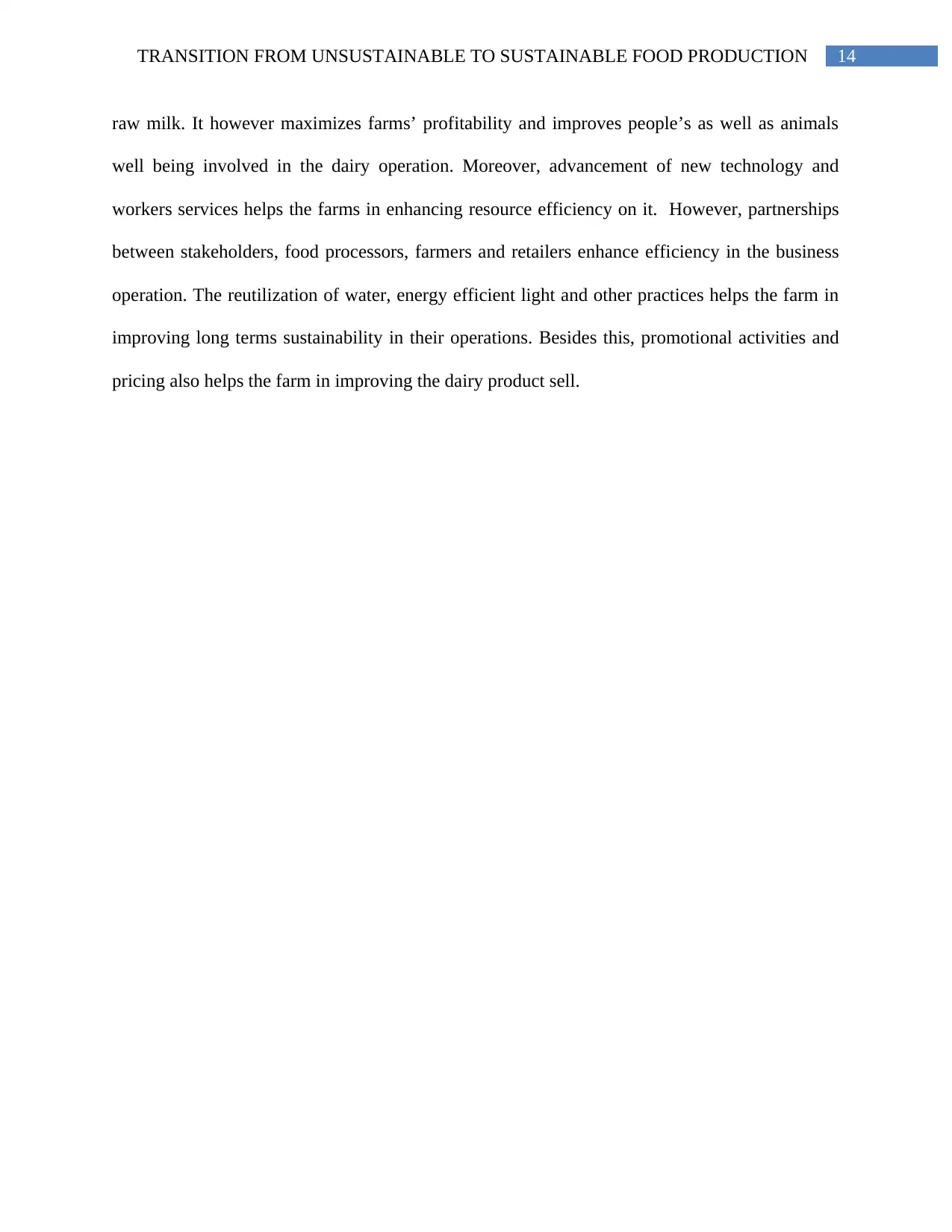
14TRANSITION FROM UNSUSTAINABLE TO SUSTAINABLE FOOD PRODUCTION
raw milk. It however maximizes farms’ profitability and improves people’s as well as animals
well being involved in the dairy operation. Moreover, advancement of new technology and
workers services helps the farms in enhancing resource efficiency on it. However, partnerships
between stakeholders, food processors, farmers and retailers enhance efficiency in the business
operation. The reutilization of water, energy efficient light and other practices helps the farm in
improving long terms sustainability in their operations. Besides this, promotional activities and
pricing also helps the farm in improving the dairy product sell.
raw milk. It however maximizes farms’ profitability and improves people’s as well as animals
well being involved in the dairy operation. Moreover, advancement of new technology and
workers services helps the farms in enhancing resource efficiency on it. However, partnerships
between stakeholders, food processors, farmers and retailers enhance efficiency in the business
operation. The reutilization of water, energy efficient light and other practices helps the farm in
improving long terms sustainability in their operations. Besides this, promotional activities and
pricing also helps the farm in improving the dairy product sell.
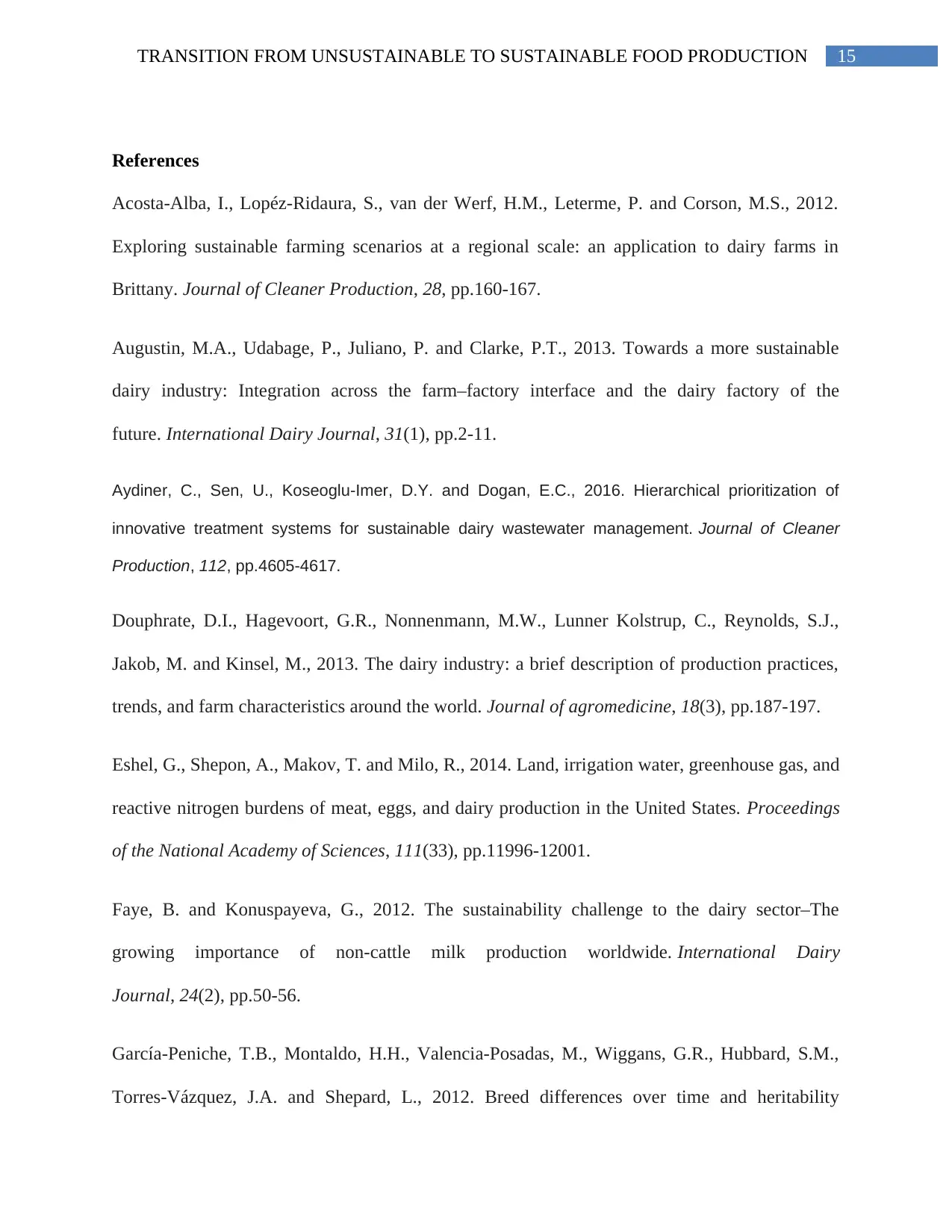
15TRANSITION FROM UNSUSTAINABLE TO SUSTAINABLE FOOD PRODUCTION
References
Acosta-Alba, I., Lopéz-Ridaura, S., van der Werf, H.M., Leterme, P. and Corson, M.S., 2012.
Exploring sustainable farming scenarios at a regional scale: an application to dairy farms in
Brittany. Journal of Cleaner Production, 28, pp.160-167.
Augustin, M.A., Udabage, P., Juliano, P. and Clarke, P.T., 2013. Towards a more sustainable
dairy industry: Integration across the farm–factory interface and the dairy factory of the
future. International Dairy Journal, 31(1), pp.2-11.
Aydiner, C., Sen, U., Koseoglu-Imer, D.Y. and Dogan, E.C., 2016. Hierarchical prioritization of
innovative treatment systems for sustainable dairy wastewater management. Journal of Cleaner
Production, 112, pp.4605-4617.
Douphrate, D.I., Hagevoort, G.R., Nonnenmann, M.W., Lunner Kolstrup, C., Reynolds, S.J.,
Jakob, M. and Kinsel, M., 2013. The dairy industry: a brief description of production practices,
trends, and farm characteristics around the world. Journal of agromedicine, 18(3), pp.187-197.
Eshel, G., Shepon, A., Makov, T. and Milo, R., 2014. Land, irrigation water, greenhouse gas, and
reactive nitrogen burdens of meat, eggs, and dairy production in the United States. Proceedings
of the National Academy of Sciences, 111(33), pp.11996-12001.
Faye, B. and Konuspayeva, G., 2012. The sustainability challenge to the dairy sector–The
growing importance of non-cattle milk production worldwide. International Dairy
Journal, 24(2), pp.50-56.
García-Peniche, T.B., Montaldo, H.H., Valencia-Posadas, M., Wiggans, G.R., Hubbard, S.M.,
Torres-Vázquez, J.A. and Shepard, L., 2012. Breed differences over time and heritability
References
Acosta-Alba, I., Lopéz-Ridaura, S., van der Werf, H.M., Leterme, P. and Corson, M.S., 2012.
Exploring sustainable farming scenarios at a regional scale: an application to dairy farms in
Brittany. Journal of Cleaner Production, 28, pp.160-167.
Augustin, M.A., Udabage, P., Juliano, P. and Clarke, P.T., 2013. Towards a more sustainable
dairy industry: Integration across the farm–factory interface and the dairy factory of the
future. International Dairy Journal, 31(1), pp.2-11.
Aydiner, C., Sen, U., Koseoglu-Imer, D.Y. and Dogan, E.C., 2016. Hierarchical prioritization of
innovative treatment systems for sustainable dairy wastewater management. Journal of Cleaner
Production, 112, pp.4605-4617.
Douphrate, D.I., Hagevoort, G.R., Nonnenmann, M.W., Lunner Kolstrup, C., Reynolds, S.J.,
Jakob, M. and Kinsel, M., 2013. The dairy industry: a brief description of production practices,
trends, and farm characteristics around the world. Journal of agromedicine, 18(3), pp.187-197.
Eshel, G., Shepon, A., Makov, T. and Milo, R., 2014. Land, irrigation water, greenhouse gas, and
reactive nitrogen burdens of meat, eggs, and dairy production in the United States. Proceedings
of the National Academy of Sciences, 111(33), pp.11996-12001.
Faye, B. and Konuspayeva, G., 2012. The sustainability challenge to the dairy sector–The
growing importance of non-cattle milk production worldwide. International Dairy
Journal, 24(2), pp.50-56.
García-Peniche, T.B., Montaldo, H.H., Valencia-Posadas, M., Wiggans, G.R., Hubbard, S.M.,
Torres-Vázquez, J.A. and Shepard, L., 2012. Breed differences over time and heritability
Secure Best Marks with AI Grader
Need help grading? Try our AI Grader for instant feedback on your assignments.
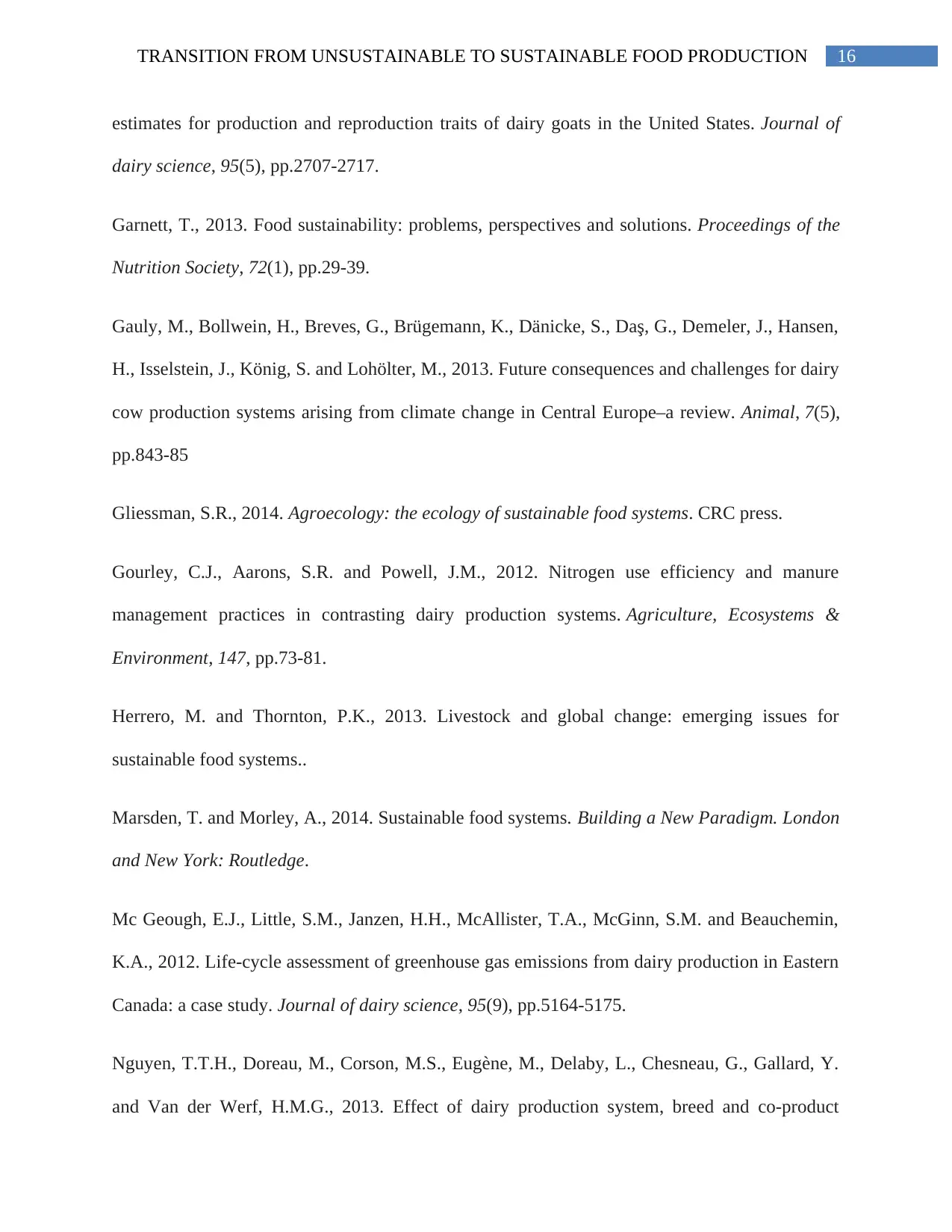
16TRANSITION FROM UNSUSTAINABLE TO SUSTAINABLE FOOD PRODUCTION
estimates for production and reproduction traits of dairy goats in the United States. Journal of
dairy science, 95(5), pp.2707-2717.
Garnett, T., 2013. Food sustainability: problems, perspectives and solutions. Proceedings of the
Nutrition Society, 72(1), pp.29-39.
Gauly, M., Bollwein, H., Breves, G., Brügemann, K., Dänicke, S., Daş, G., Demeler, J., Hansen,
H., Isselstein, J., König, S. and Lohölter, M., 2013. Future consequences and challenges for dairy
cow production systems arising from climate change in Central Europe–a review. Animal, 7(5),
pp.843-85
Gliessman, S.R., 2014. Agroecology: the ecology of sustainable food systems. CRC press.
Gourley, C.J., Aarons, S.R. and Powell, J.M., 2012. Nitrogen use efficiency and manure
management practices in contrasting dairy production systems. Agriculture, Ecosystems &
Environment, 147, pp.73-81.
Herrero, M. and Thornton, P.K., 2013. Livestock and global change: emerging issues for
sustainable food systems..
Marsden, T. and Morley, A., 2014. Sustainable food systems. Building a New Paradigm. London
and New York: Routledge.
Mc Geough, E.J., Little, S.M., Janzen, H.H., McAllister, T.A., McGinn, S.M. and Beauchemin,
K.A., 2012. Life-cycle assessment of greenhouse gas emissions from dairy production in Eastern
Canada: a case study. Journal of dairy science, 95(9), pp.5164-5175.
Nguyen, T.T.H., Doreau, M., Corson, M.S., Eugène, M., Delaby, L., Chesneau, G., Gallard, Y.
and Van der Werf, H.M.G., 2013. Effect of dairy production system, breed and co-product
estimates for production and reproduction traits of dairy goats in the United States. Journal of
dairy science, 95(5), pp.2707-2717.
Garnett, T., 2013. Food sustainability: problems, perspectives and solutions. Proceedings of the
Nutrition Society, 72(1), pp.29-39.
Gauly, M., Bollwein, H., Breves, G., Brügemann, K., Dänicke, S., Daş, G., Demeler, J., Hansen,
H., Isselstein, J., König, S. and Lohölter, M., 2013. Future consequences and challenges for dairy
cow production systems arising from climate change in Central Europe–a review. Animal, 7(5),
pp.843-85
Gliessman, S.R., 2014. Agroecology: the ecology of sustainable food systems. CRC press.
Gourley, C.J., Aarons, S.R. and Powell, J.M., 2012. Nitrogen use efficiency and manure
management practices in contrasting dairy production systems. Agriculture, Ecosystems &
Environment, 147, pp.73-81.
Herrero, M. and Thornton, P.K., 2013. Livestock and global change: emerging issues for
sustainable food systems..
Marsden, T. and Morley, A., 2014. Sustainable food systems. Building a New Paradigm. London
and New York: Routledge.
Mc Geough, E.J., Little, S.M., Janzen, H.H., McAllister, T.A., McGinn, S.M. and Beauchemin,
K.A., 2012. Life-cycle assessment of greenhouse gas emissions from dairy production in Eastern
Canada: a case study. Journal of dairy science, 95(9), pp.5164-5175.
Nguyen, T.T.H., Doreau, M., Corson, M.S., Eugène, M., Delaby, L., Chesneau, G., Gallard, Y.
and Van der Werf, H.M.G., 2013. Effect of dairy production system, breed and co-product
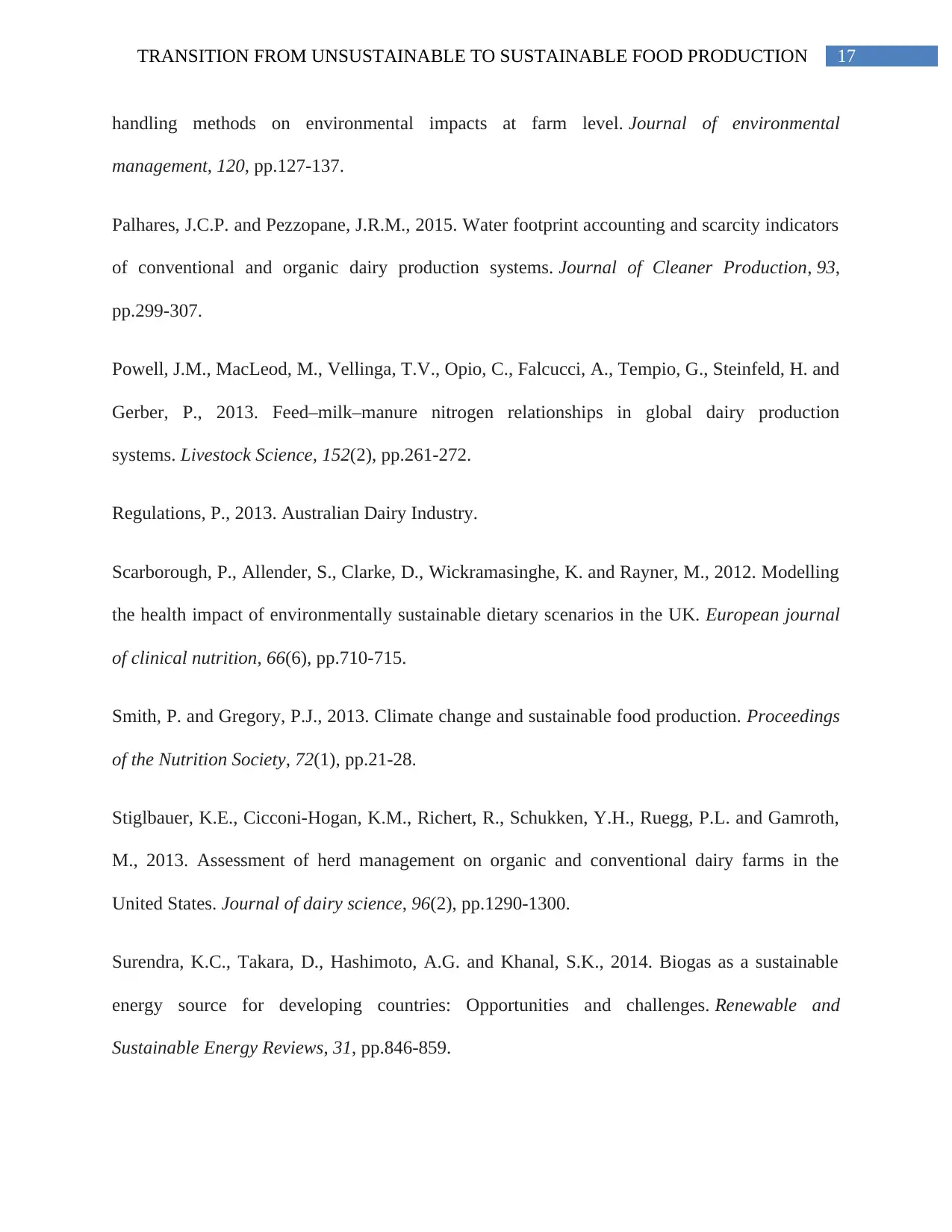
17TRANSITION FROM UNSUSTAINABLE TO SUSTAINABLE FOOD PRODUCTION
handling methods on environmental impacts at farm level. Journal of environmental
management, 120, pp.127-137.
Palhares, J.C.P. and Pezzopane, J.R.M., 2015. Water footprint accounting and scarcity indicators
of conventional and organic dairy production systems. Journal of Cleaner Production, 93,
pp.299-307.
Powell, J.M., MacLeod, M., Vellinga, T.V., Opio, C., Falcucci, A., Tempio, G., Steinfeld, H. and
Gerber, P., 2013. Feed–milk–manure nitrogen relationships in global dairy production
systems. Livestock Science, 152(2), pp.261-272.
Regulations, P., 2013. Australian Dairy Industry.
Scarborough, P., Allender, S., Clarke, D., Wickramasinghe, K. and Rayner, M., 2012. Modelling
the health impact of environmentally sustainable dietary scenarios in the UK. European journal
of clinical nutrition, 66(6), pp.710-715.
Smith, P. and Gregory, P.J., 2013. Climate change and sustainable food production. Proceedings
of the Nutrition Society, 72(1), pp.21-28.
Stiglbauer, K.E., Cicconi-Hogan, K.M., Richert, R., Schukken, Y.H., Ruegg, P.L. and Gamroth,
M., 2013. Assessment of herd management on organic and conventional dairy farms in the
United States. Journal of dairy science, 96(2), pp.1290-1300.
Surendra, K.C., Takara, D., Hashimoto, A.G. and Khanal, S.K., 2014. Biogas as a sustainable
energy source for developing countries: Opportunities and challenges. Renewable and
Sustainable Energy Reviews, 31, pp.846-859.
handling methods on environmental impacts at farm level. Journal of environmental
management, 120, pp.127-137.
Palhares, J.C.P. and Pezzopane, J.R.M., 2015. Water footprint accounting and scarcity indicators
of conventional and organic dairy production systems. Journal of Cleaner Production, 93,
pp.299-307.
Powell, J.M., MacLeod, M., Vellinga, T.V., Opio, C., Falcucci, A., Tempio, G., Steinfeld, H. and
Gerber, P., 2013. Feed–milk–manure nitrogen relationships in global dairy production
systems. Livestock Science, 152(2), pp.261-272.
Regulations, P., 2013. Australian Dairy Industry.
Scarborough, P., Allender, S., Clarke, D., Wickramasinghe, K. and Rayner, M., 2012. Modelling
the health impact of environmentally sustainable dietary scenarios in the UK. European journal
of clinical nutrition, 66(6), pp.710-715.
Smith, P. and Gregory, P.J., 2013. Climate change and sustainable food production. Proceedings
of the Nutrition Society, 72(1), pp.21-28.
Stiglbauer, K.E., Cicconi-Hogan, K.M., Richert, R., Schukken, Y.H., Ruegg, P.L. and Gamroth,
M., 2013. Assessment of herd management on organic and conventional dairy farms in the
United States. Journal of dairy science, 96(2), pp.1290-1300.
Surendra, K.C., Takara, D., Hashimoto, A.G. and Khanal, S.K., 2014. Biogas as a sustainable
energy source for developing countries: Opportunities and challenges. Renewable and
Sustainable Energy Reviews, 31, pp.846-859.
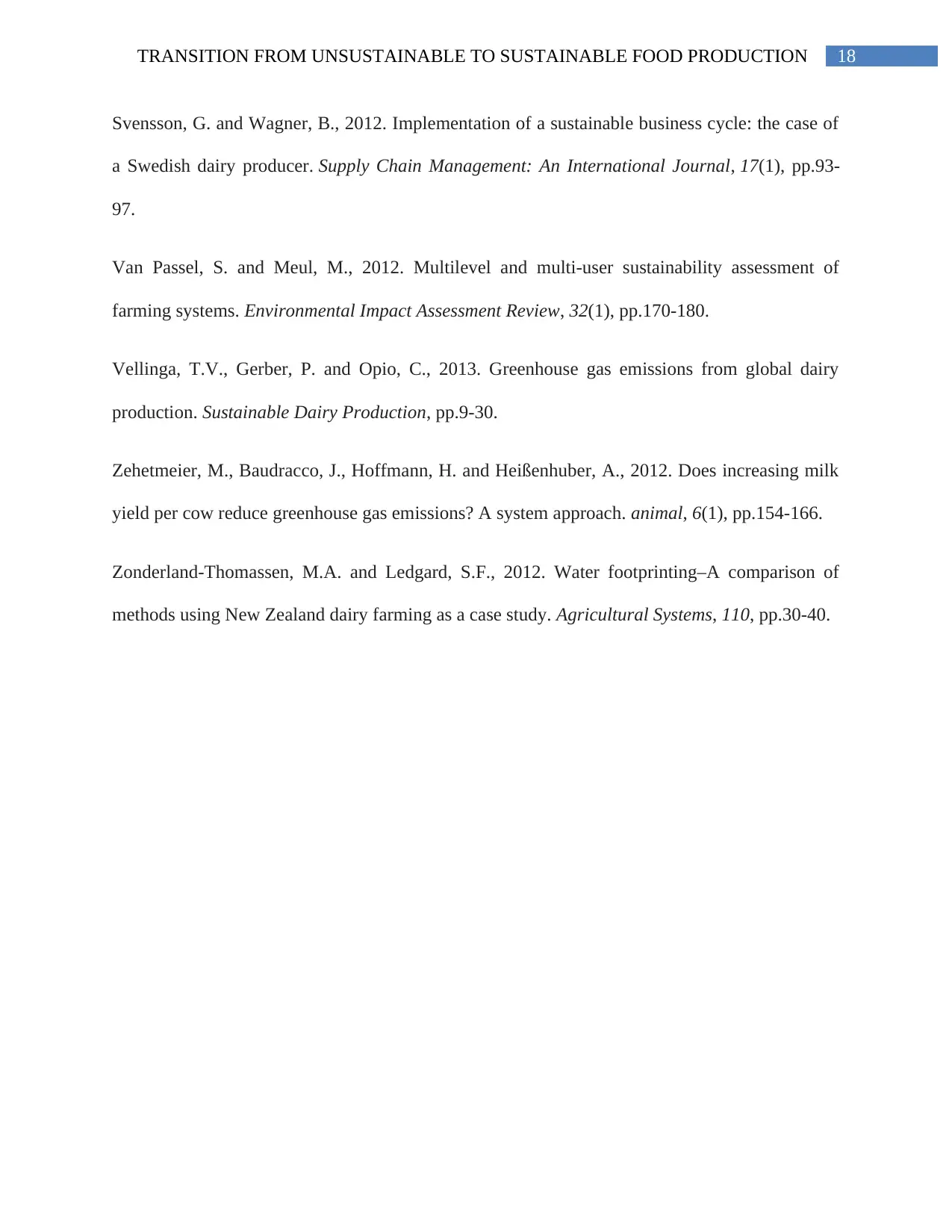
18TRANSITION FROM UNSUSTAINABLE TO SUSTAINABLE FOOD PRODUCTION
Svensson, G. and Wagner, B., 2012. Implementation of a sustainable business cycle: the case of
a Swedish dairy producer. Supply Chain Management: An International Journal, 17(1), pp.93-
97.
Van Passel, S. and Meul, M., 2012. Multilevel and multi-user sustainability assessment of
farming systems. Environmental Impact Assessment Review, 32(1), pp.170-180.
Vellinga, T.V., Gerber, P. and Opio, C., 2013. Greenhouse gas emissions from global dairy
production. Sustainable Dairy Production, pp.9-30.
Zehetmeier, M., Baudracco, J., Hoffmann, H. and Heißenhuber, A., 2012. Does increasing milk
yield per cow reduce greenhouse gas emissions? A system approach. animal, 6(1), pp.154-166.
Zonderland-Thomassen, M.A. and Ledgard, S.F., 2012. Water footprinting–A comparison of
methods using New Zealand dairy farming as a case study. Agricultural Systems, 110, pp.30-40.
Svensson, G. and Wagner, B., 2012. Implementation of a sustainable business cycle: the case of
a Swedish dairy producer. Supply Chain Management: An International Journal, 17(1), pp.93-
97.
Van Passel, S. and Meul, M., 2012. Multilevel and multi-user sustainability assessment of
farming systems. Environmental Impact Assessment Review, 32(1), pp.170-180.
Vellinga, T.V., Gerber, P. and Opio, C., 2013. Greenhouse gas emissions from global dairy
production. Sustainable Dairy Production, pp.9-30.
Zehetmeier, M., Baudracco, J., Hoffmann, H. and Heißenhuber, A., 2012. Does increasing milk
yield per cow reduce greenhouse gas emissions? A system approach. animal, 6(1), pp.154-166.
Zonderland-Thomassen, M.A. and Ledgard, S.F., 2012. Water footprinting–A comparison of
methods using New Zealand dairy farming as a case study. Agricultural Systems, 110, pp.30-40.
1 out of 19
Related Documents
Your All-in-One AI-Powered Toolkit for Academic Success.
+13062052269
info@desklib.com
Available 24*7 on WhatsApp / Email
![[object Object]](/_next/static/media/star-bottom.7253800d.svg)
Unlock your academic potential
© 2024 | Zucol Services PVT LTD | All rights reserved.





